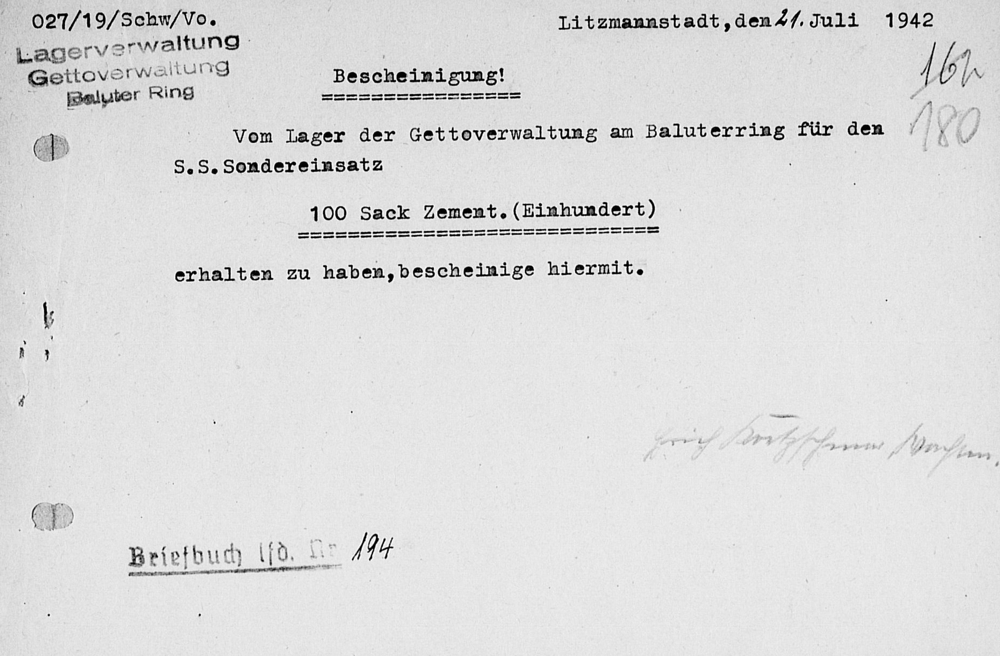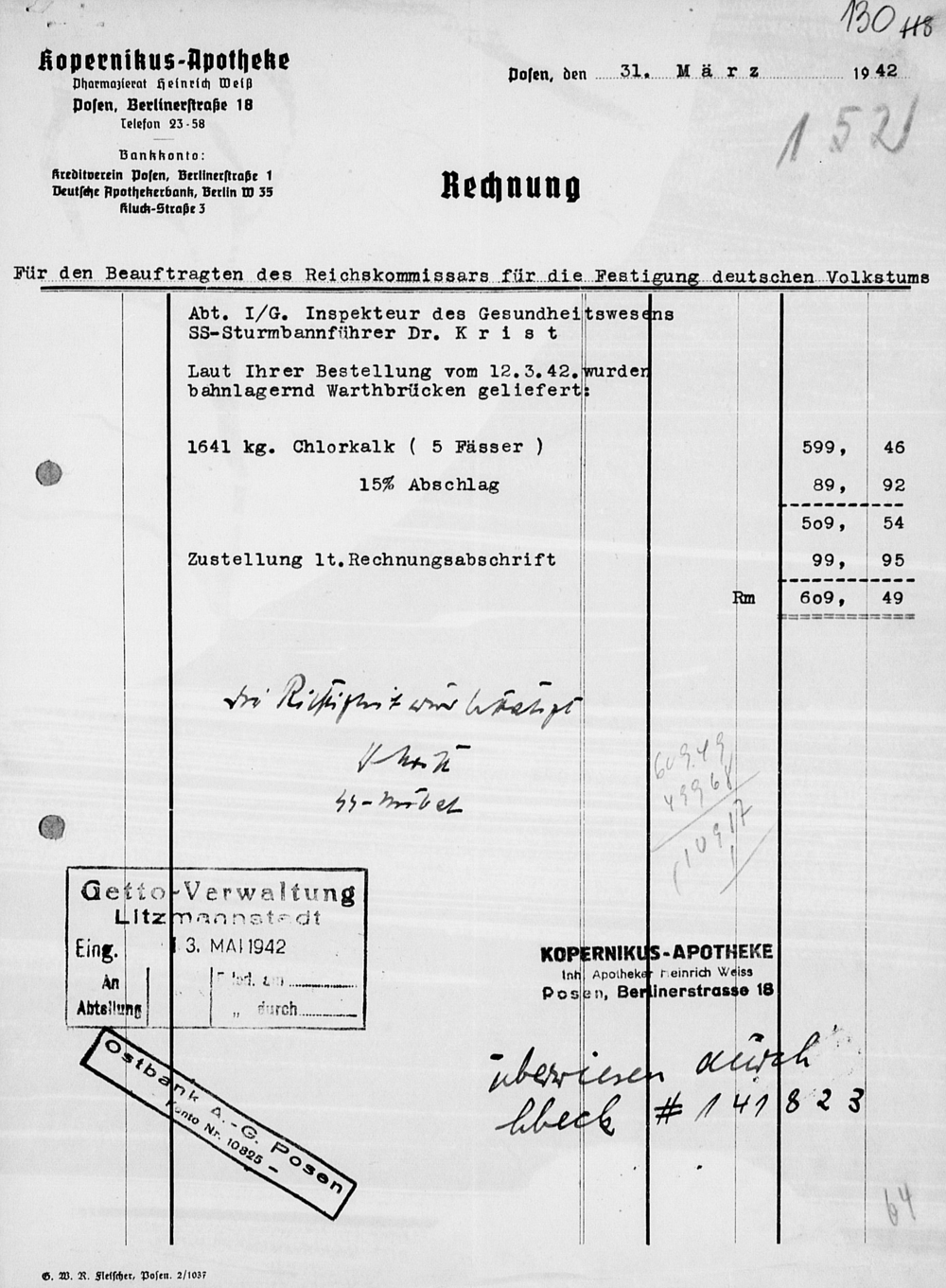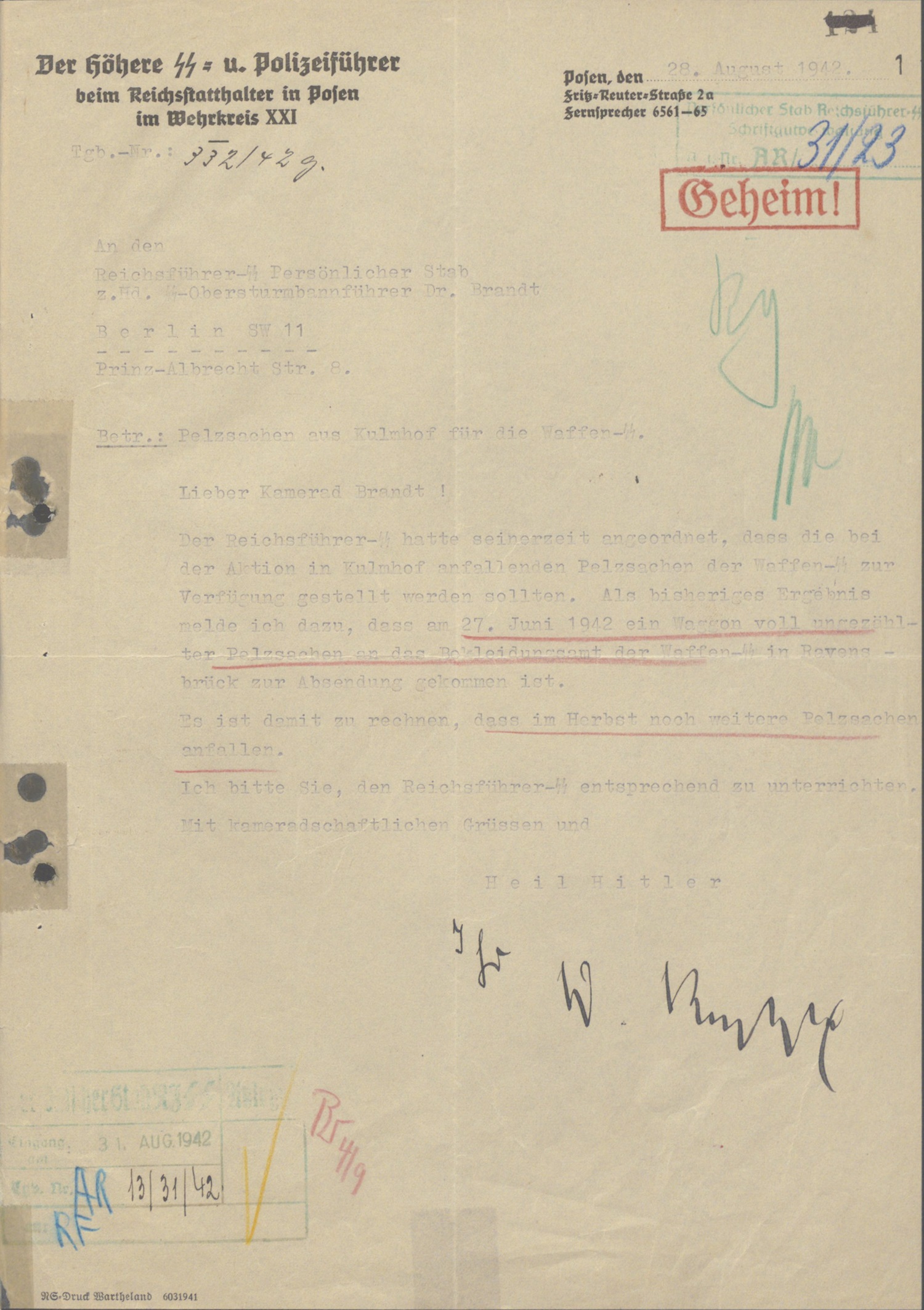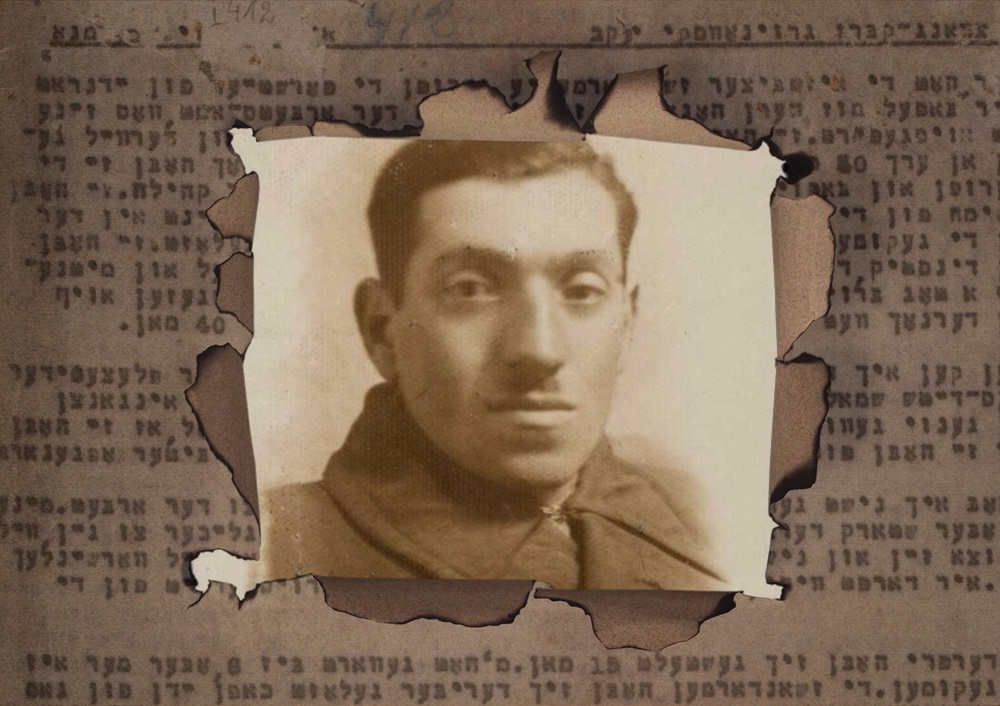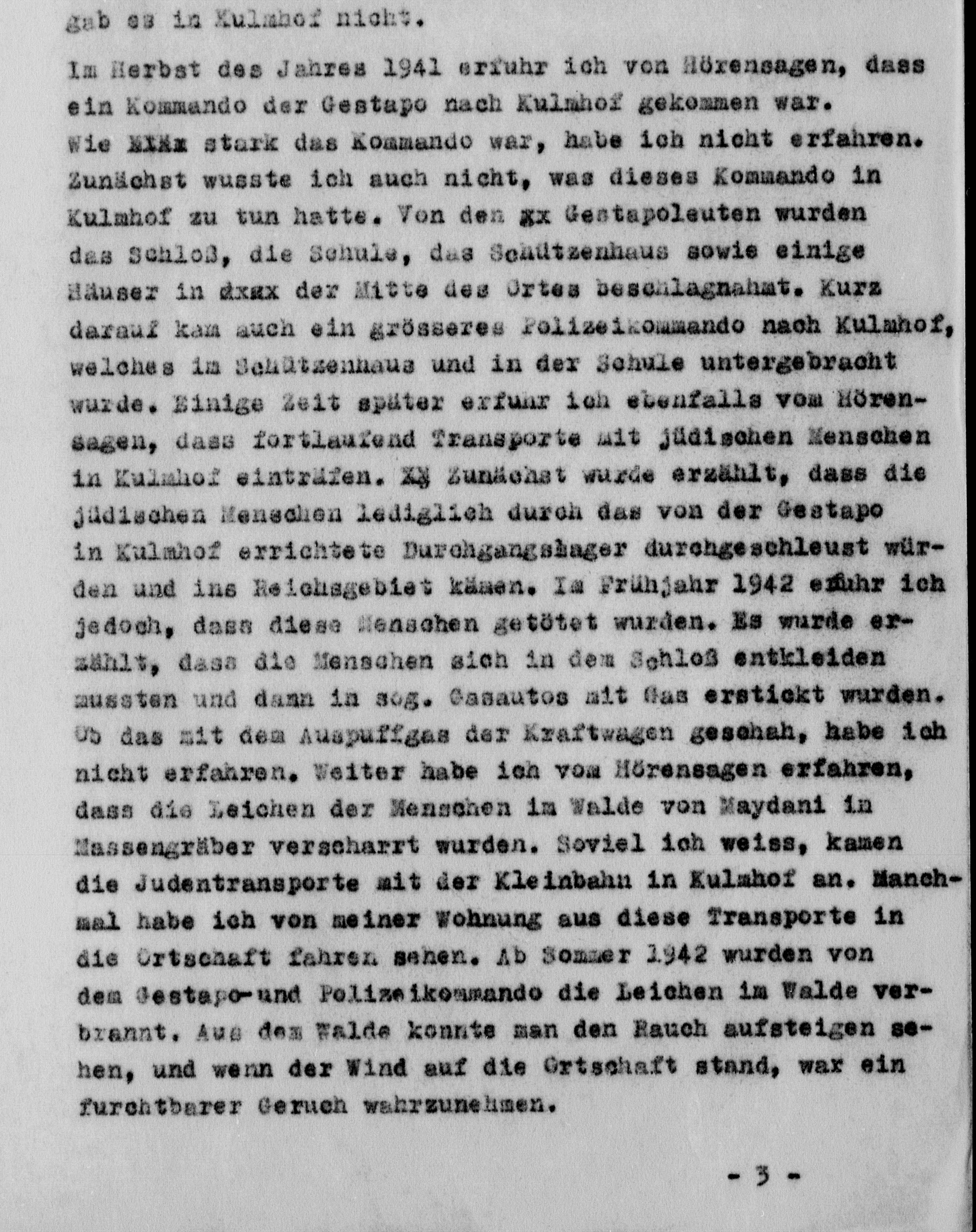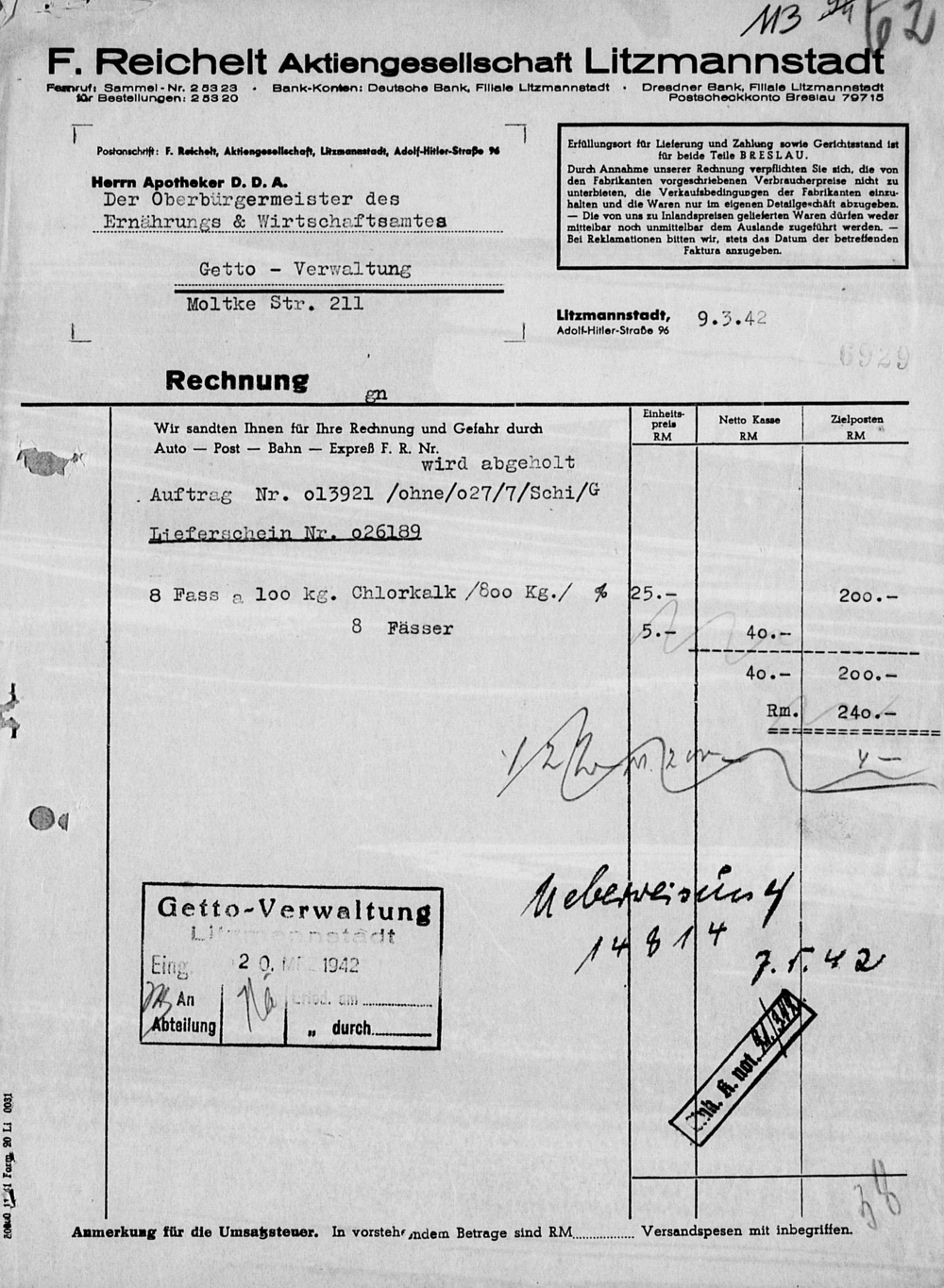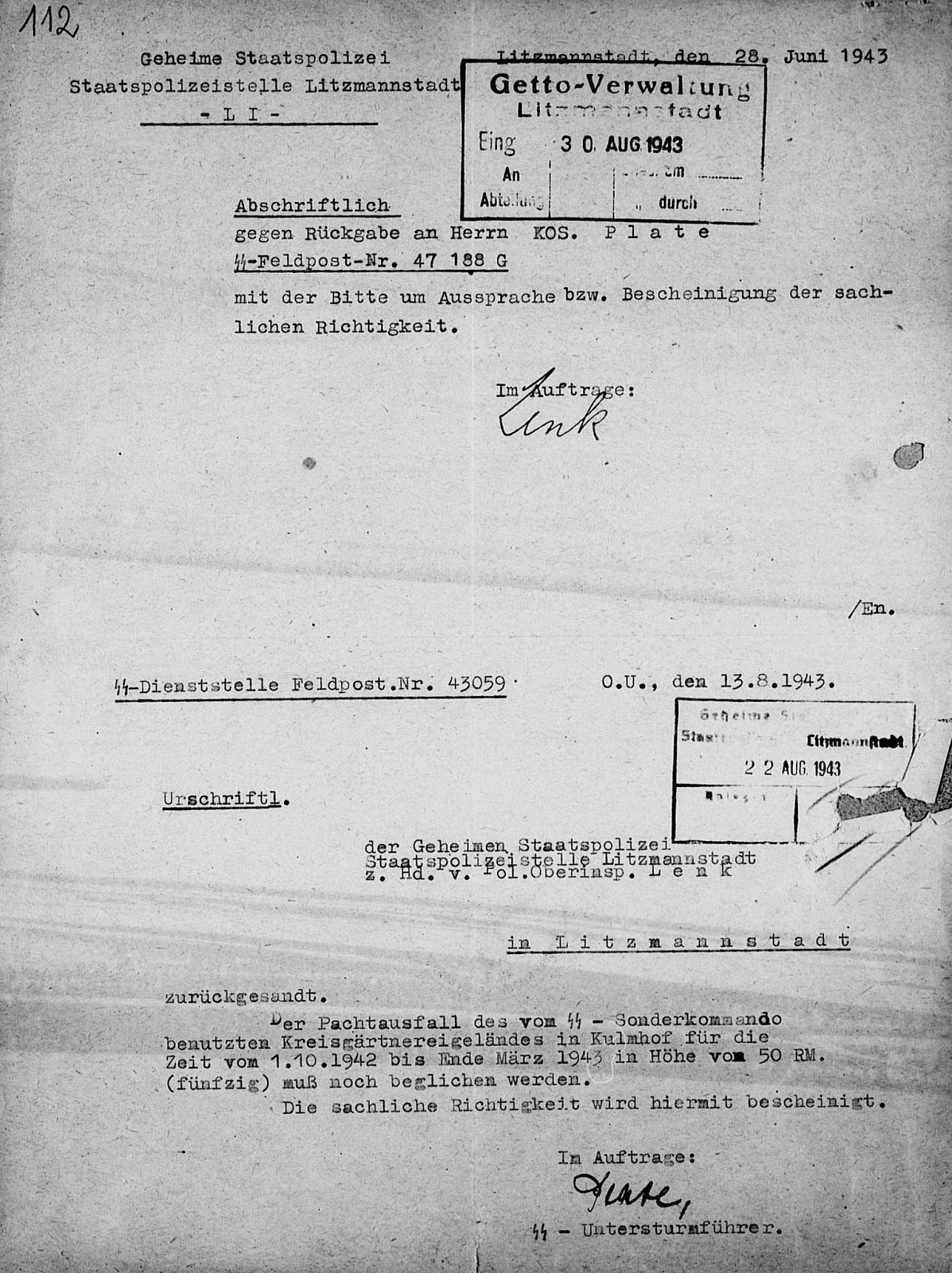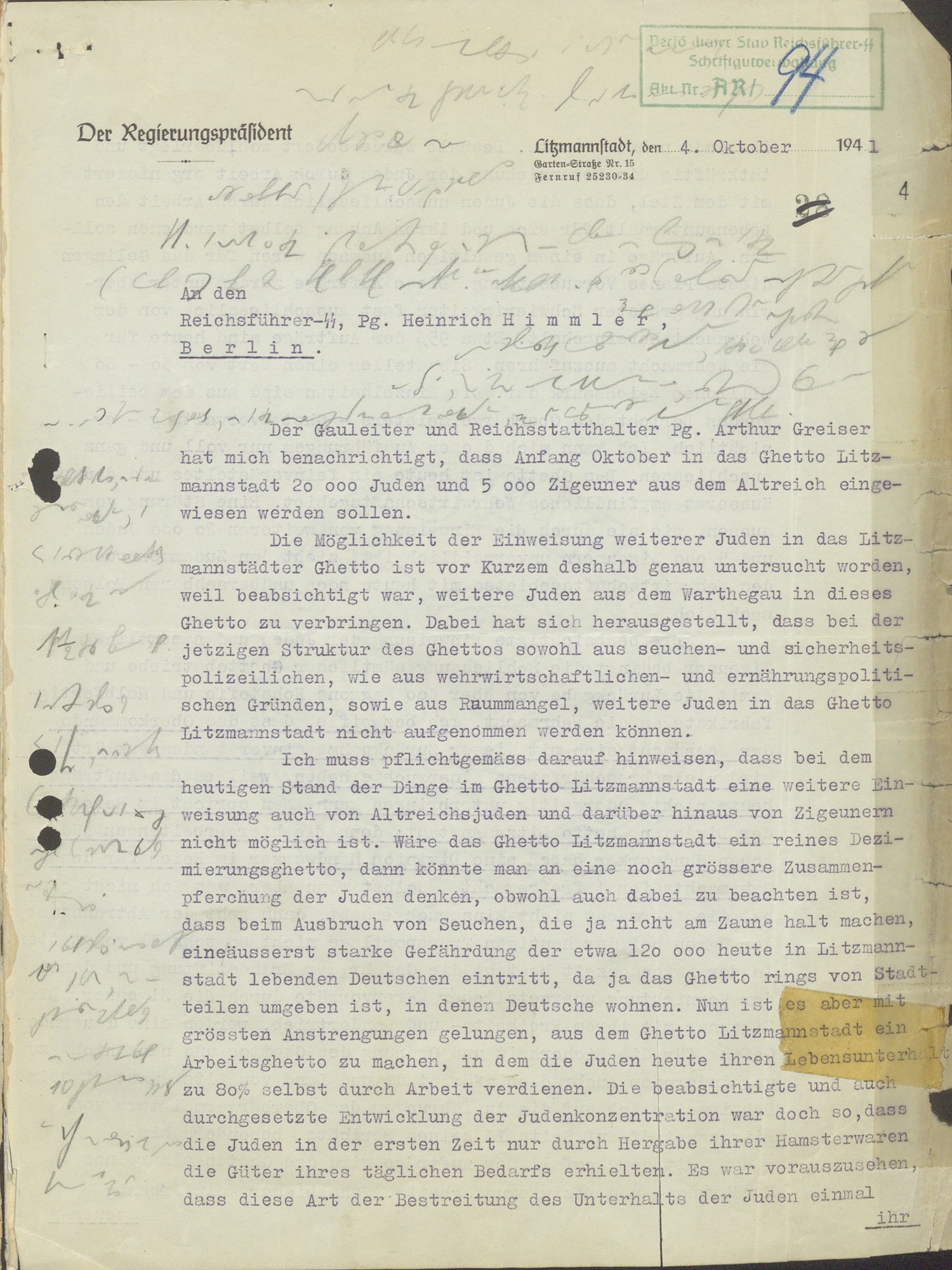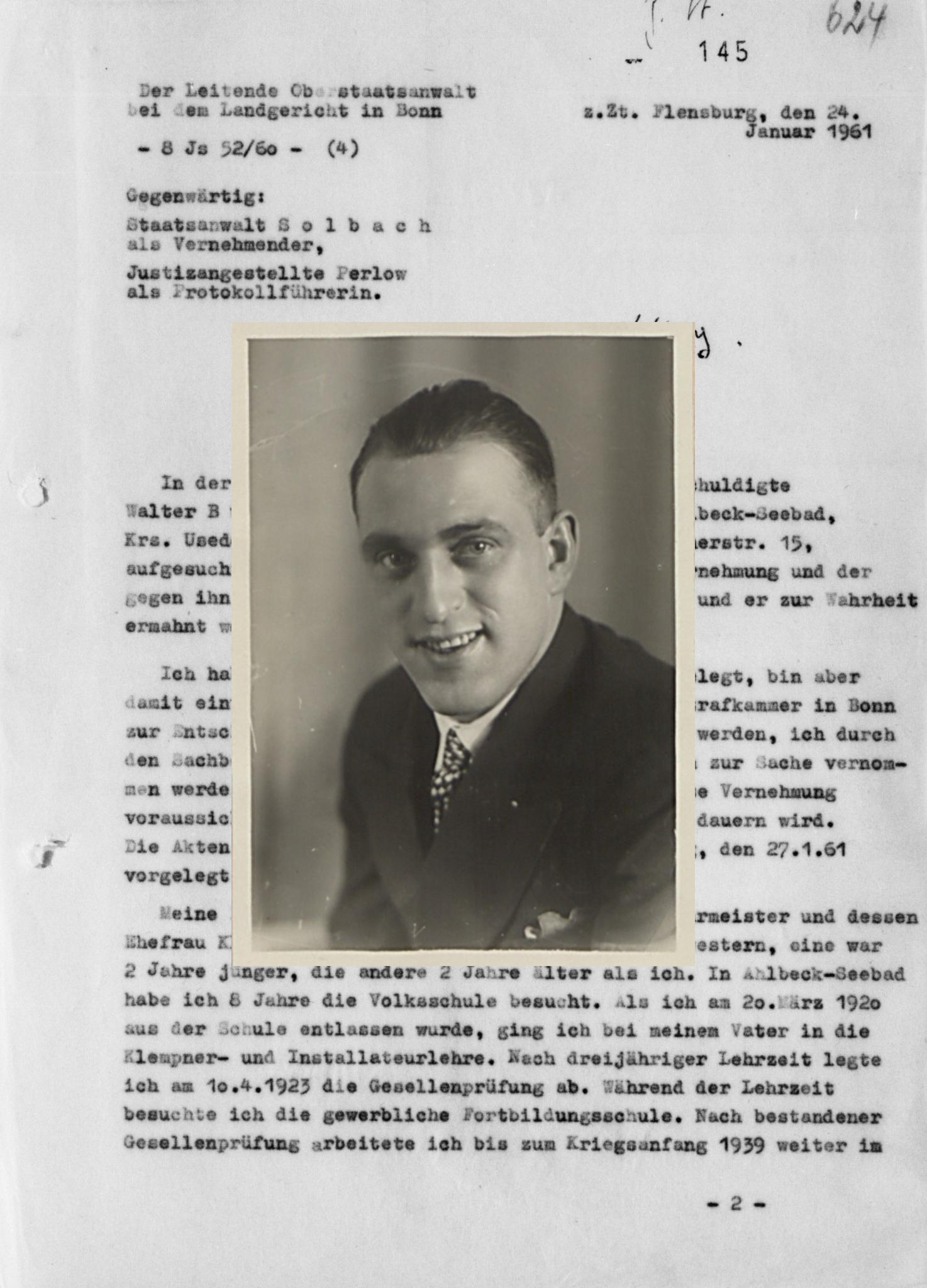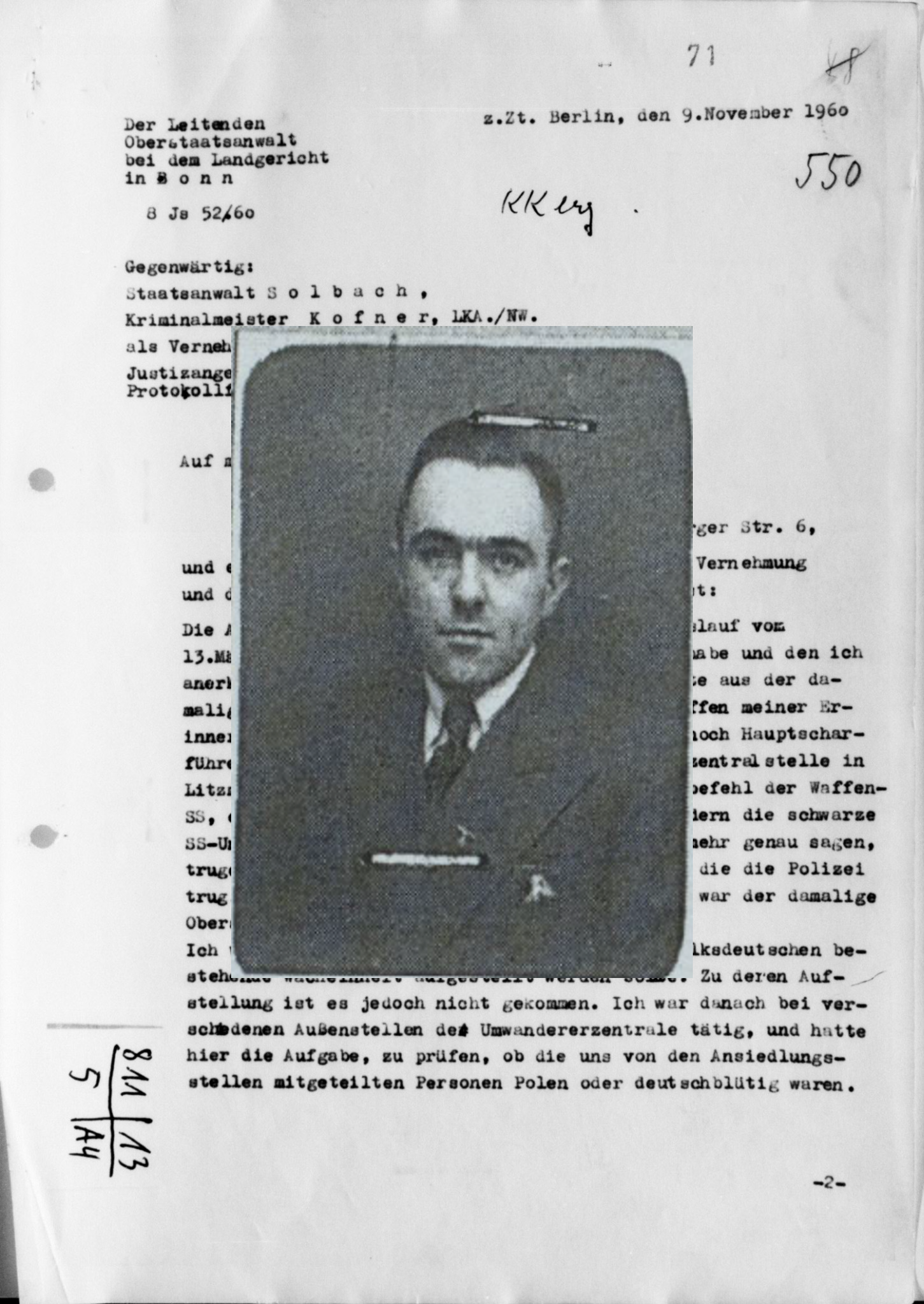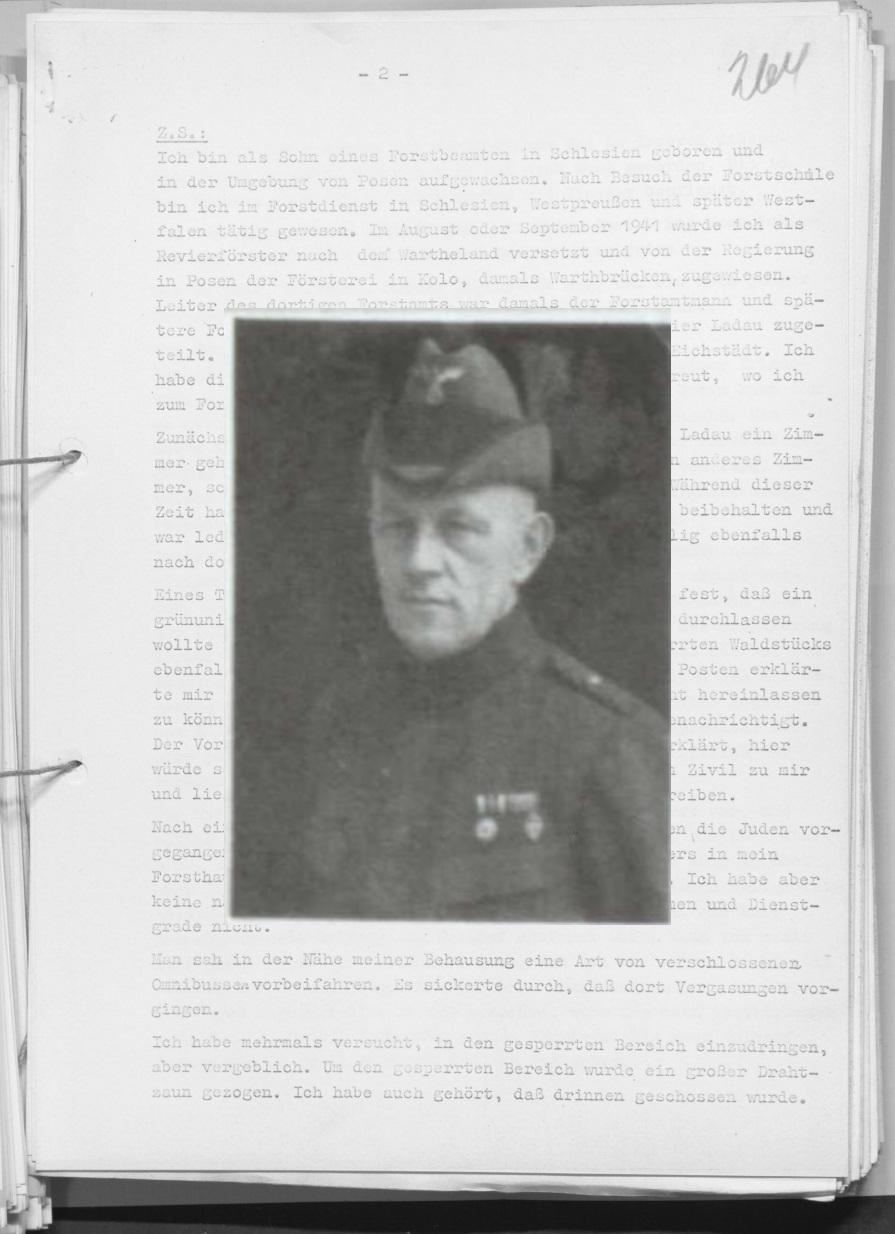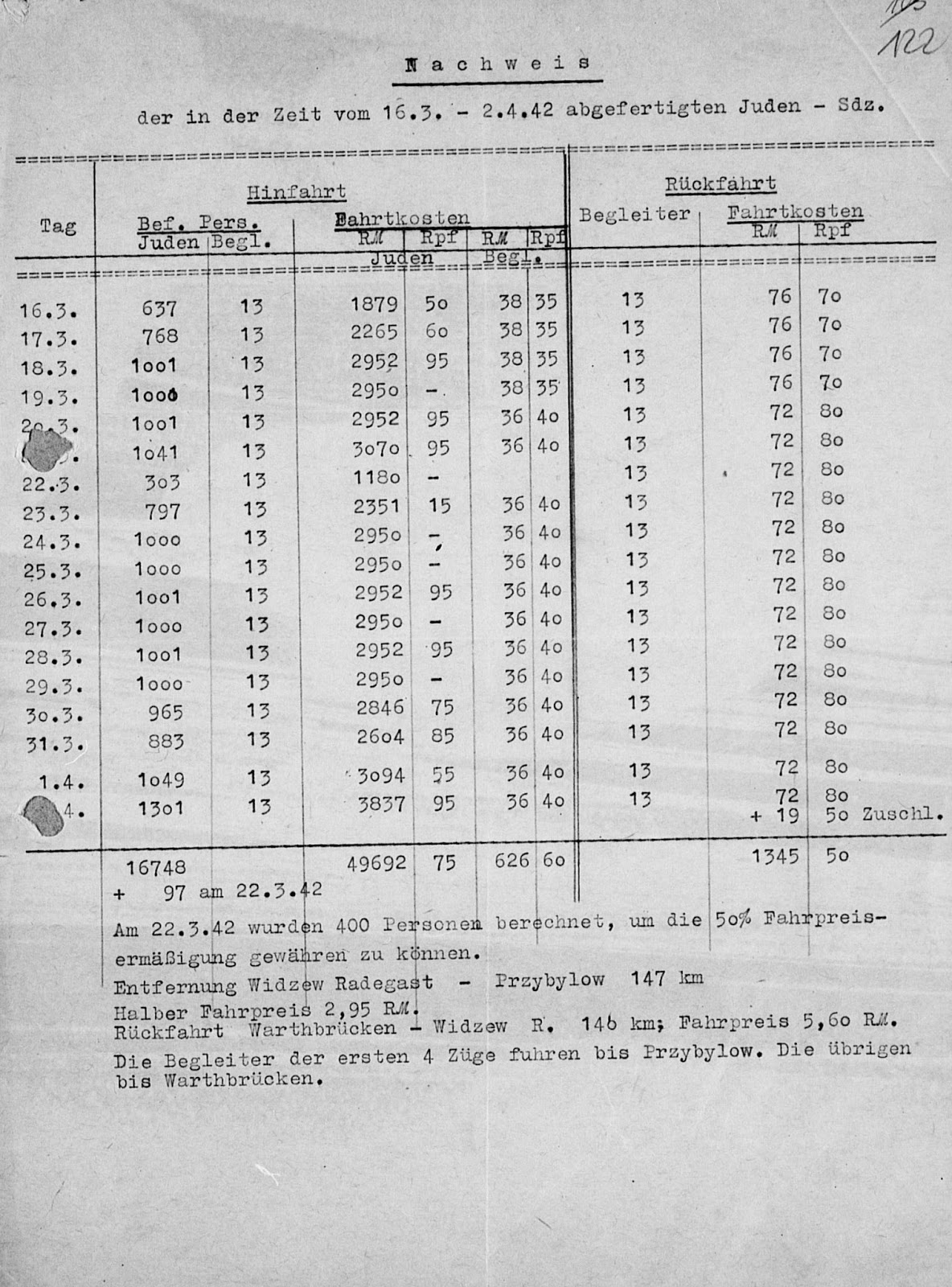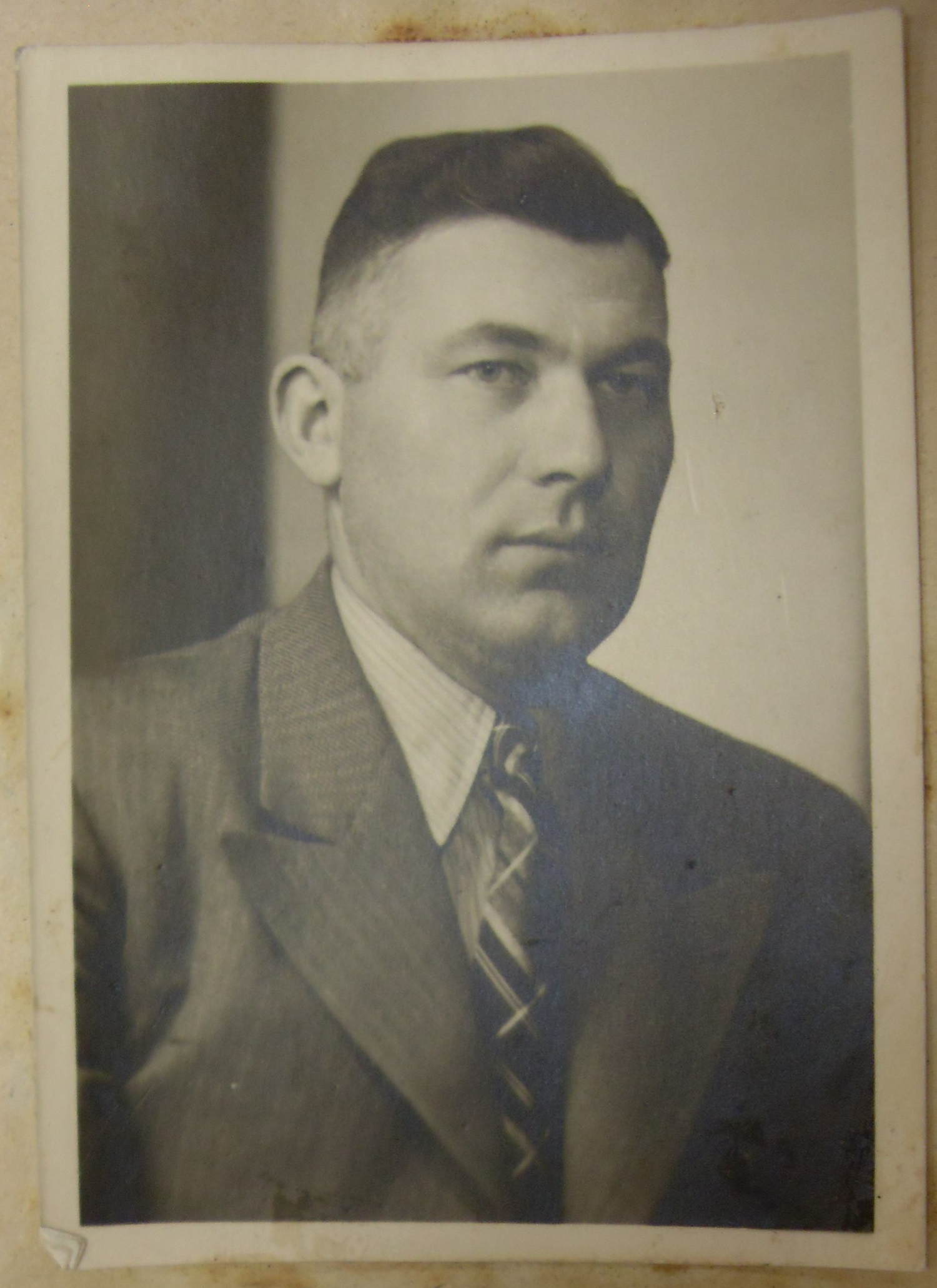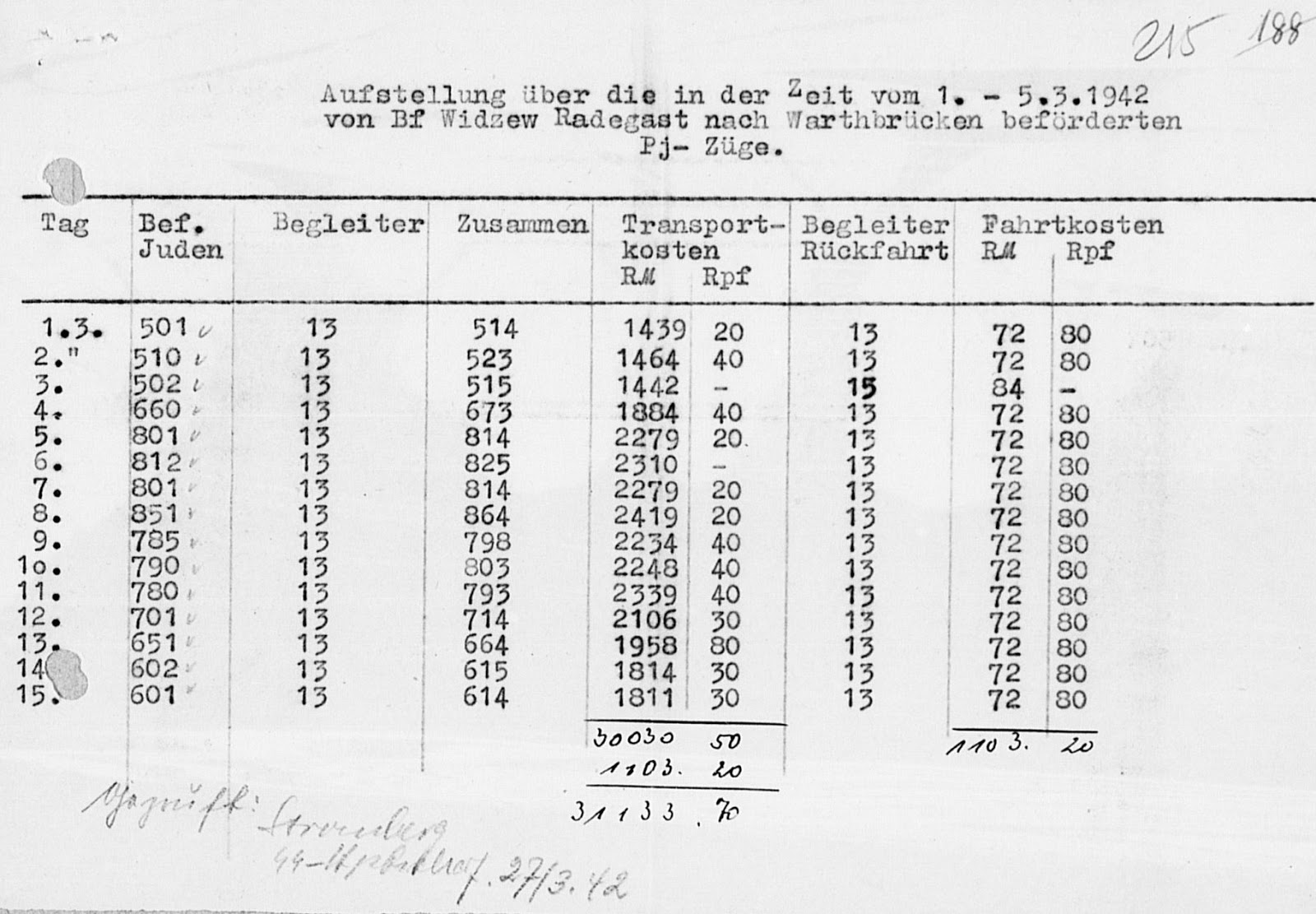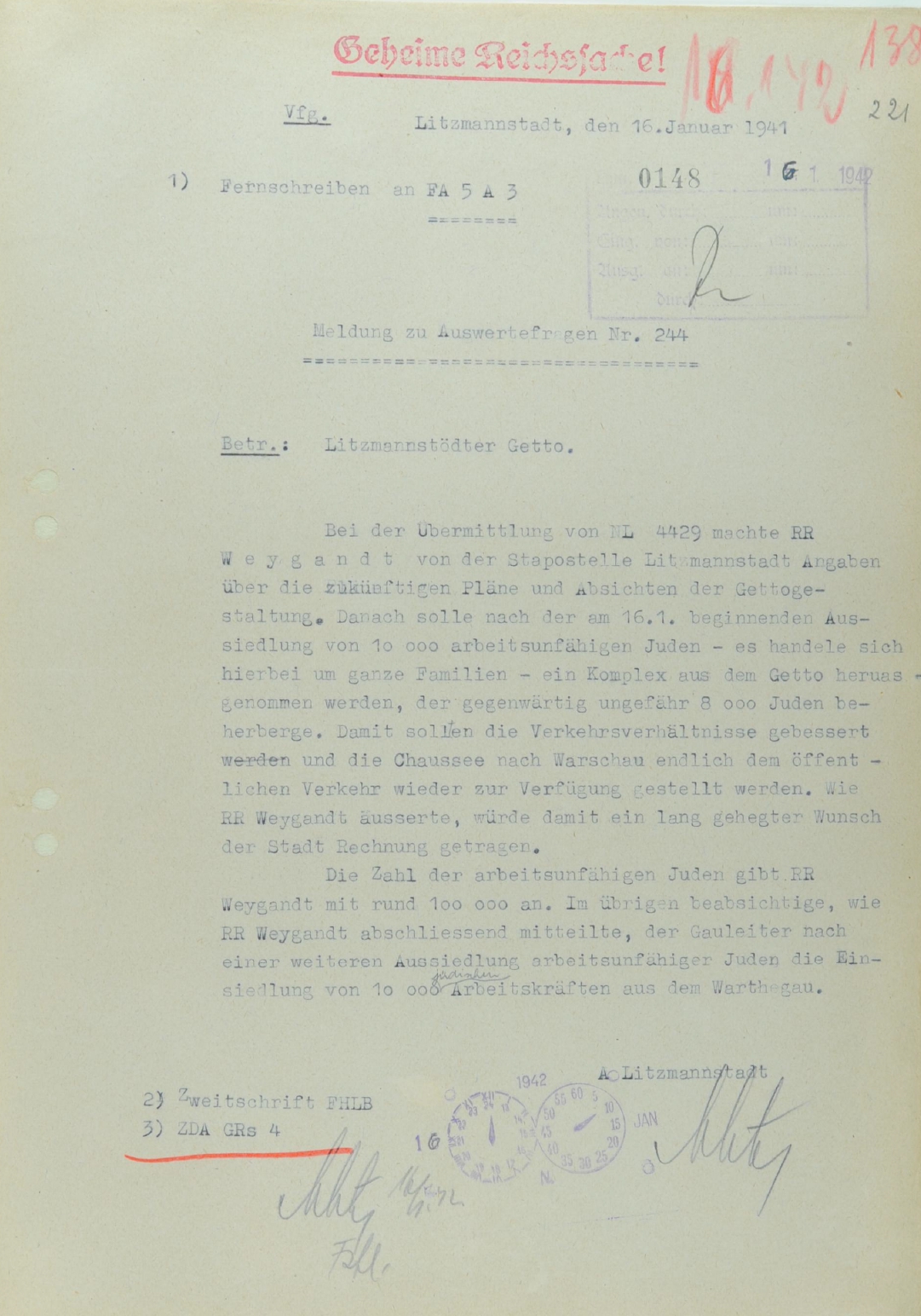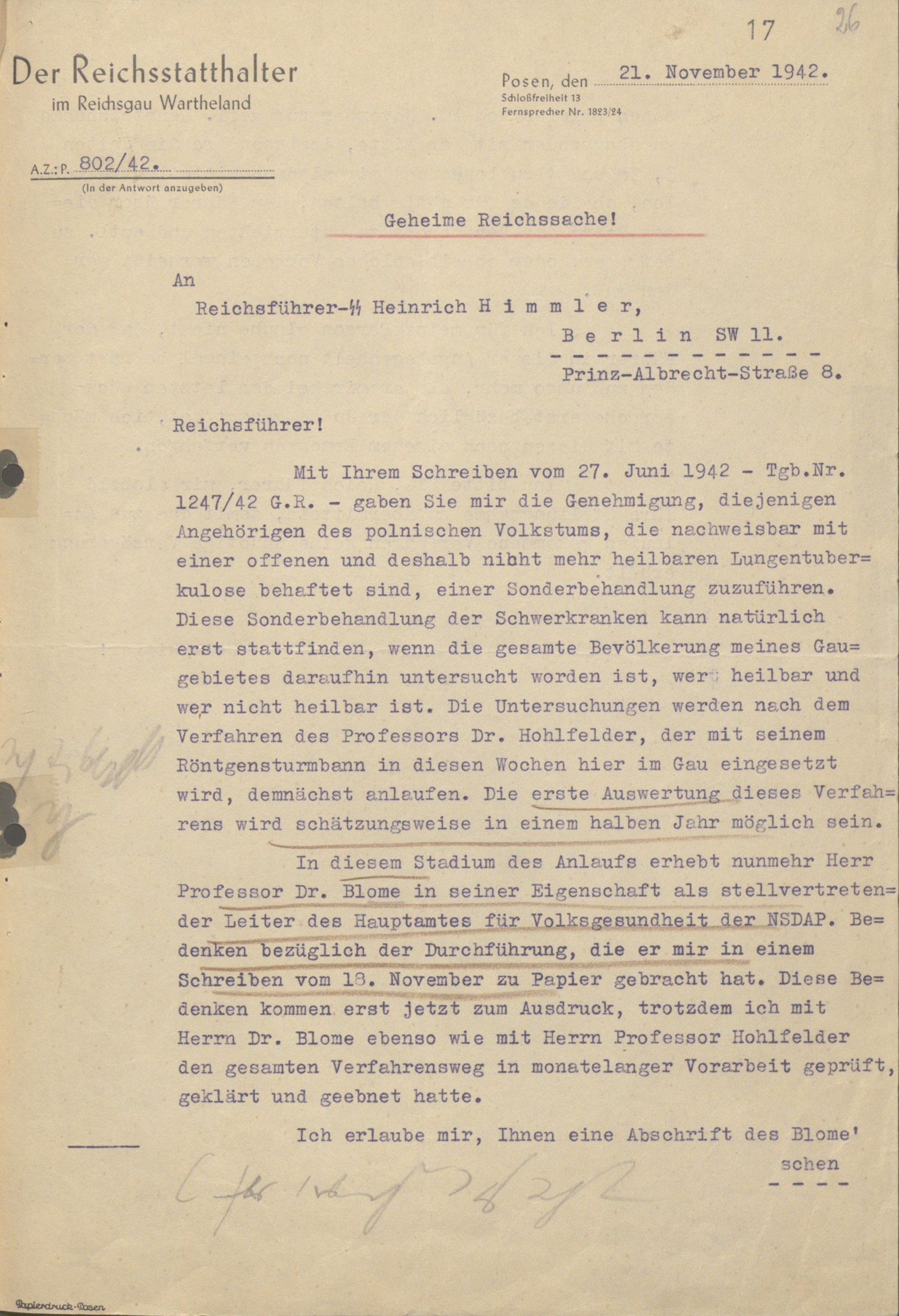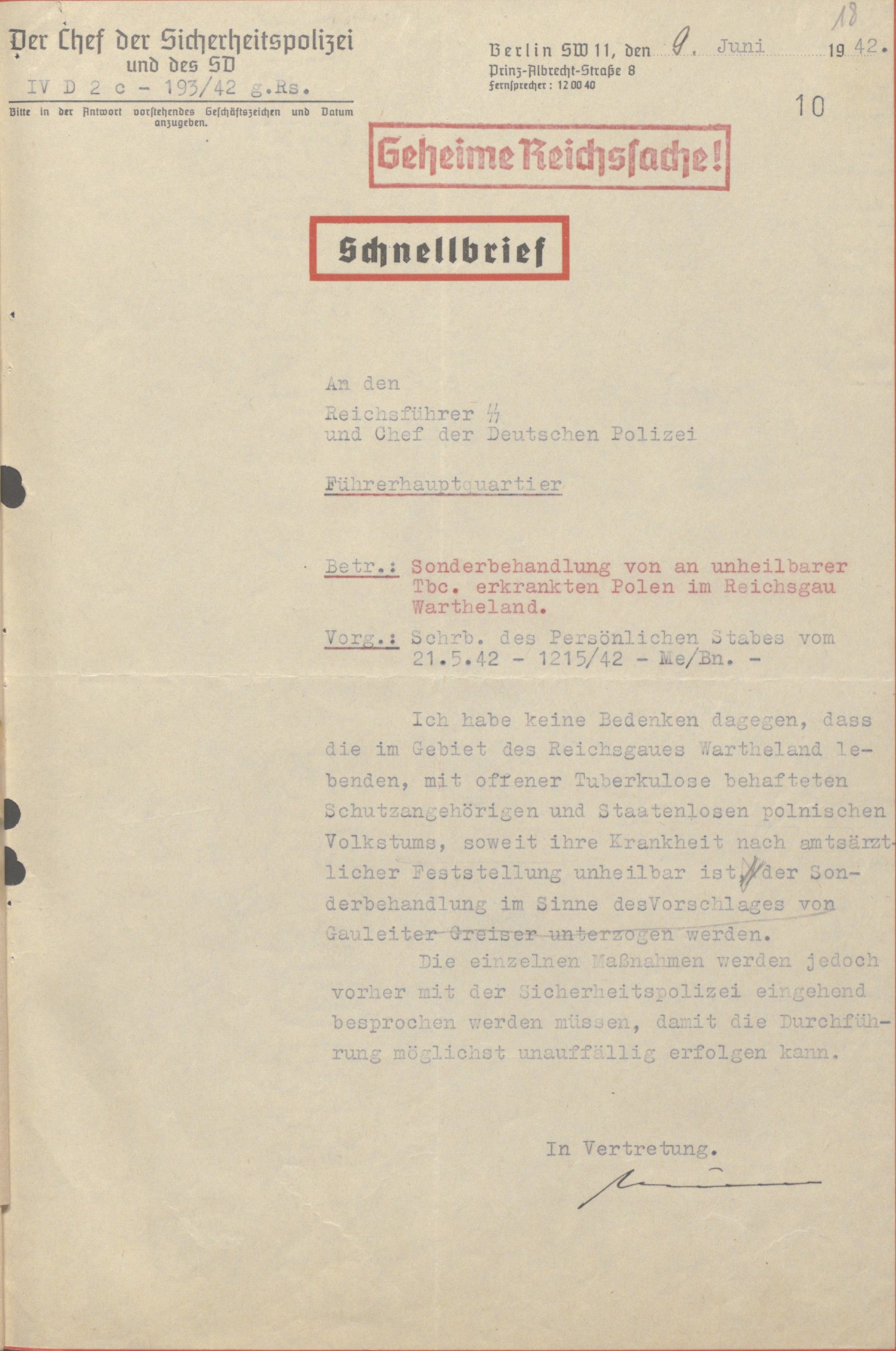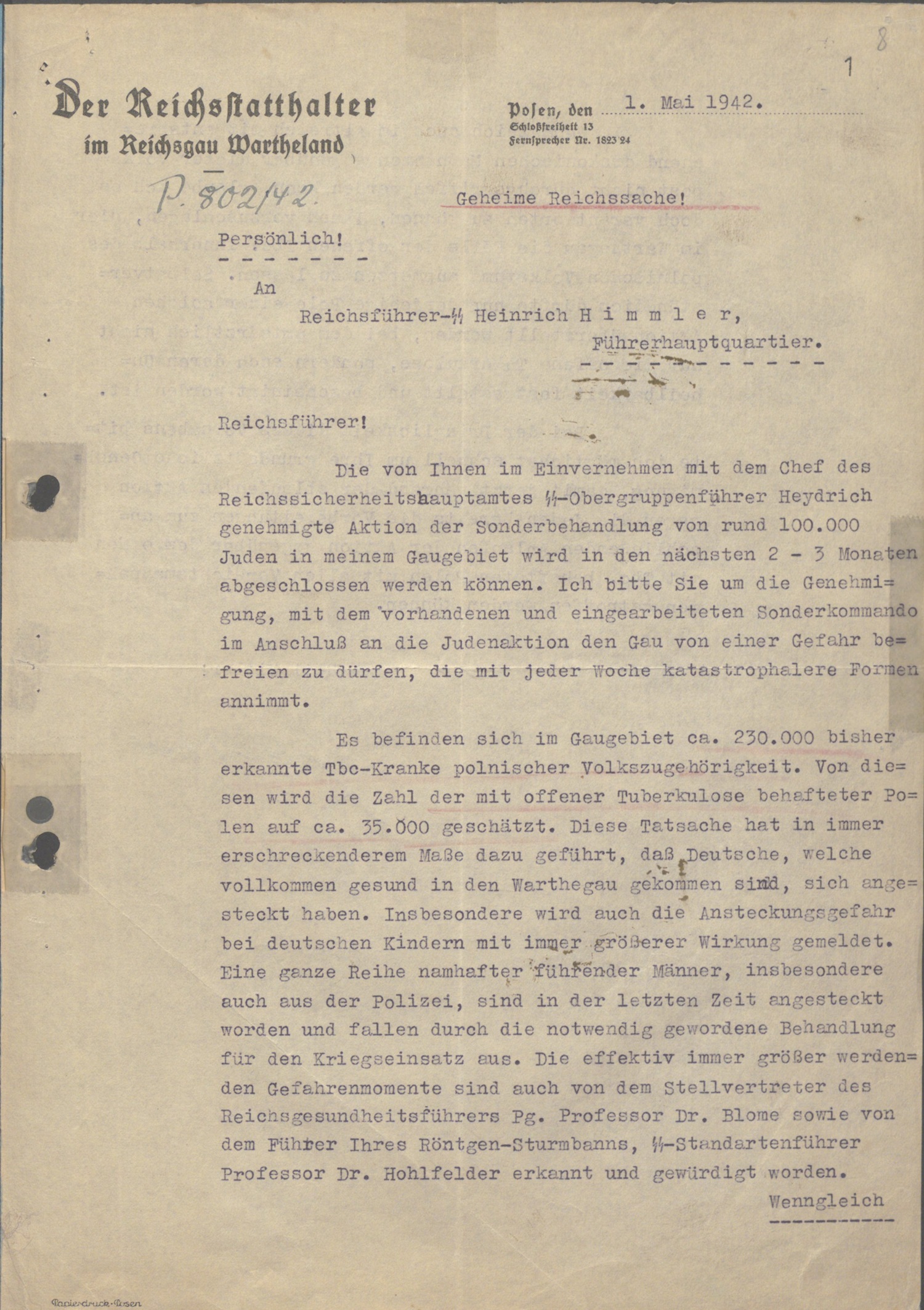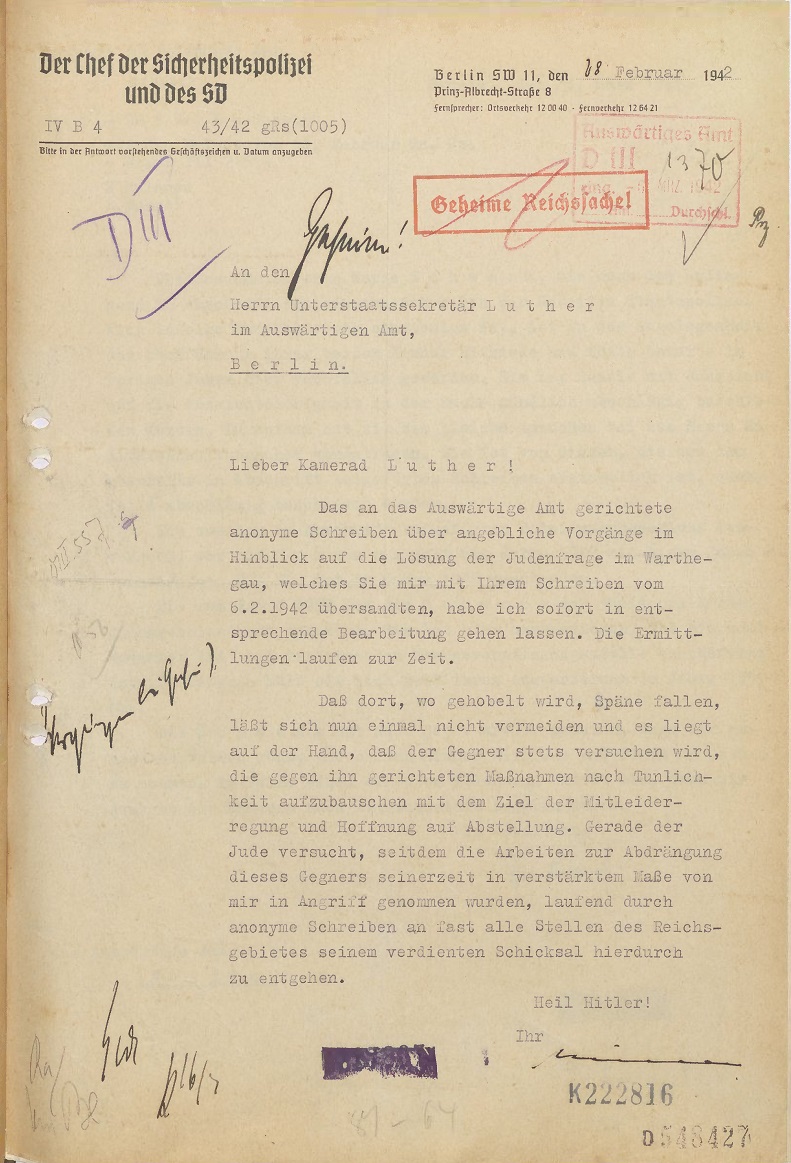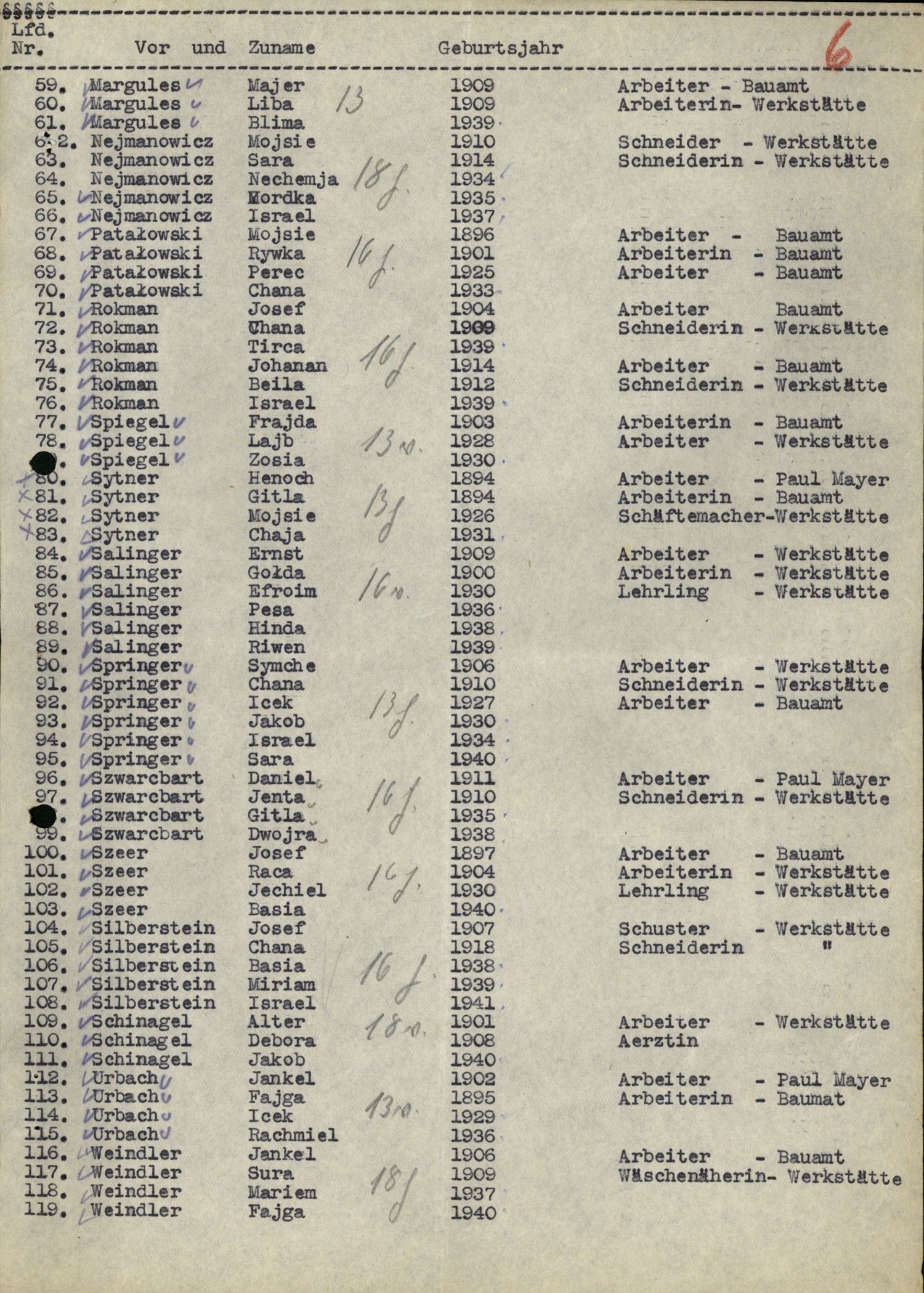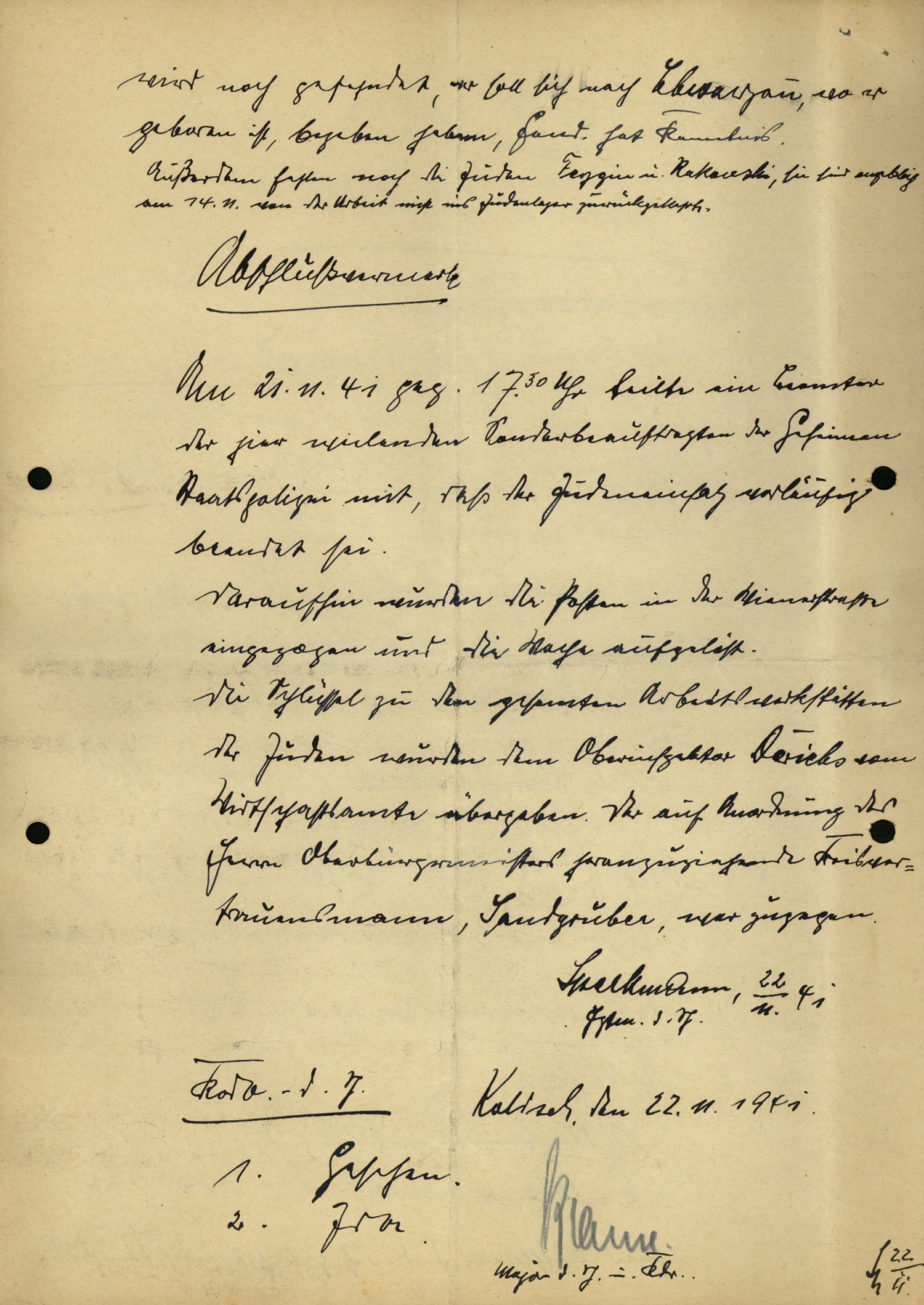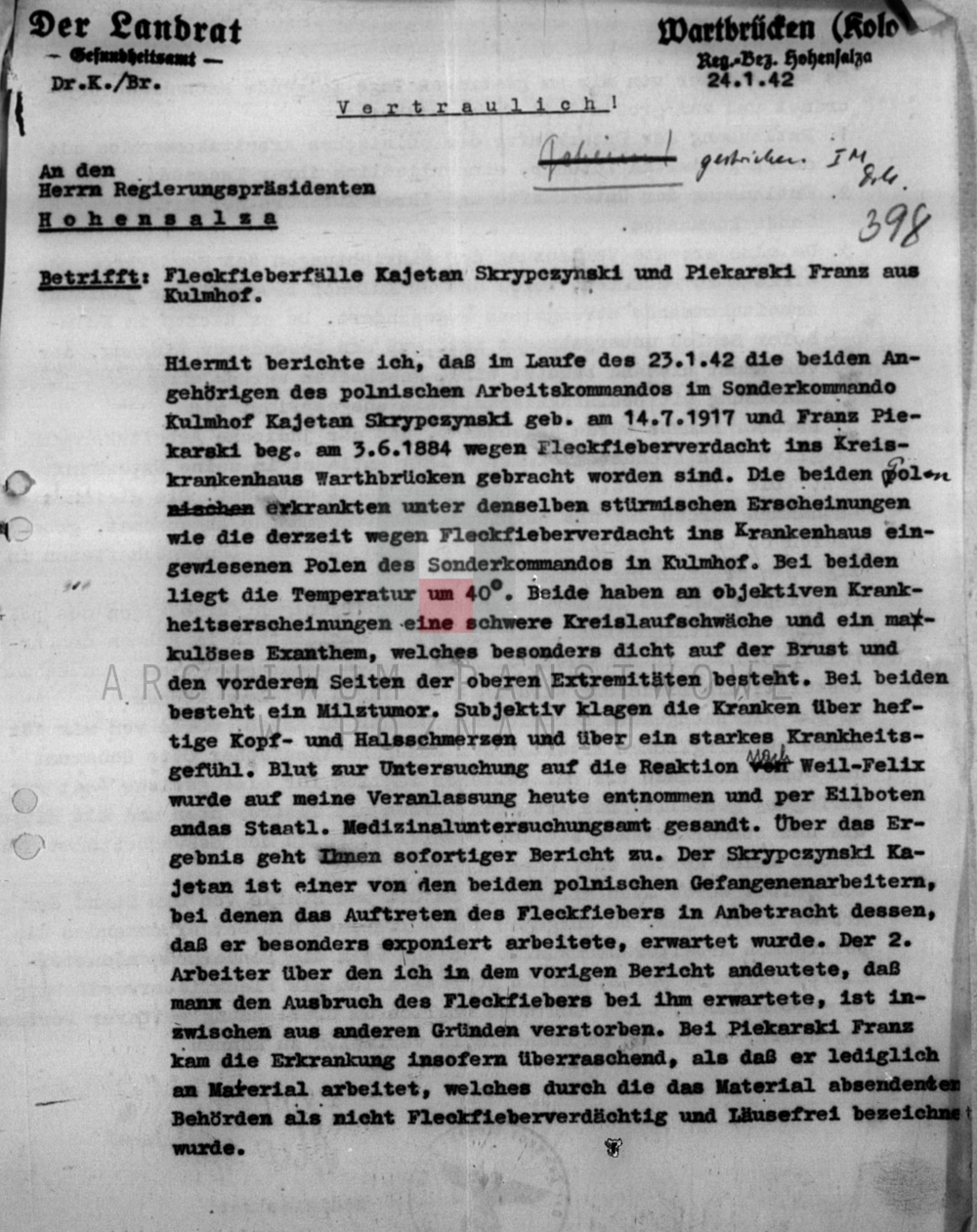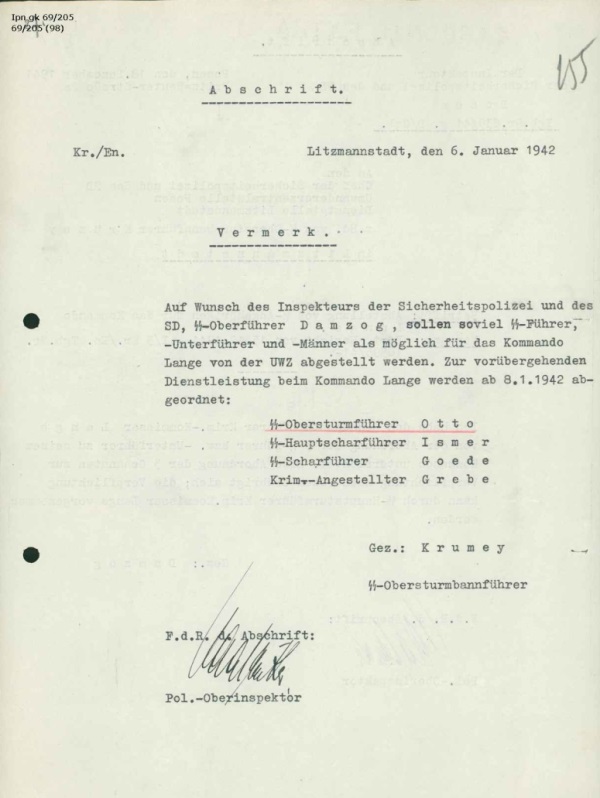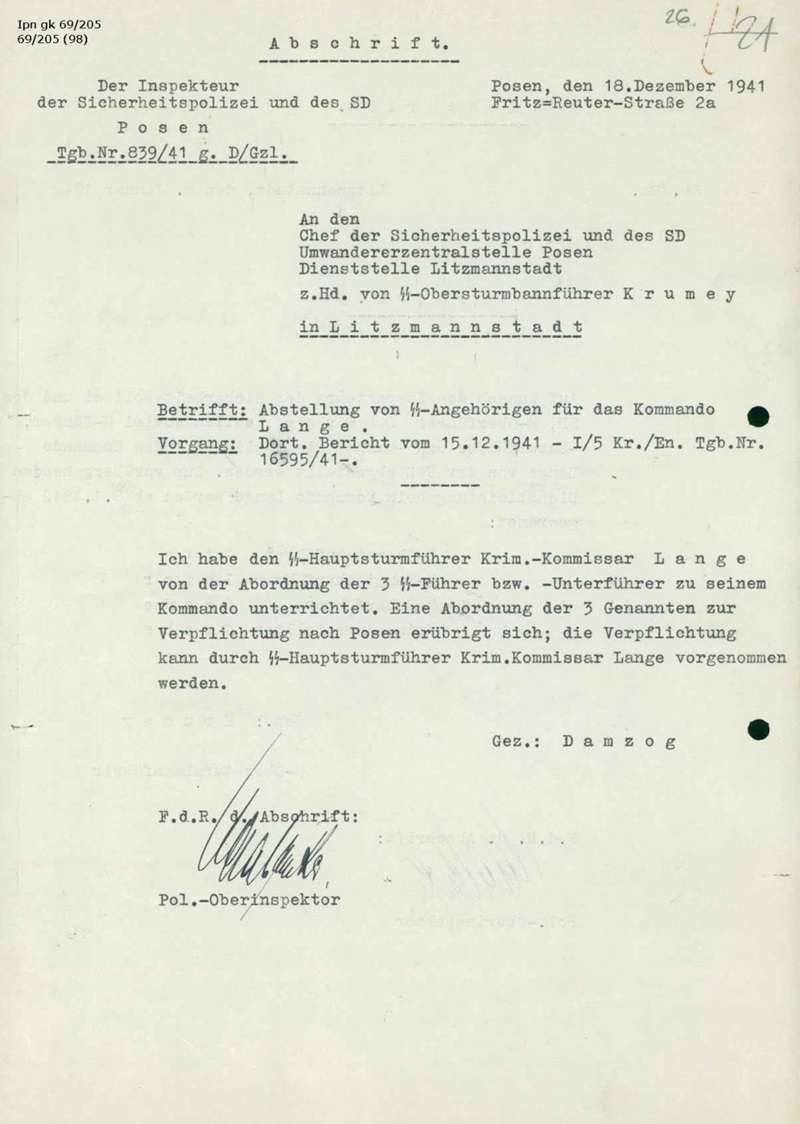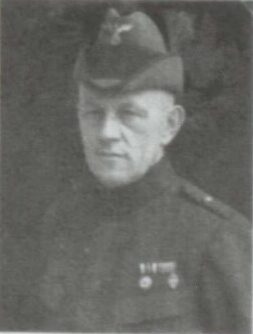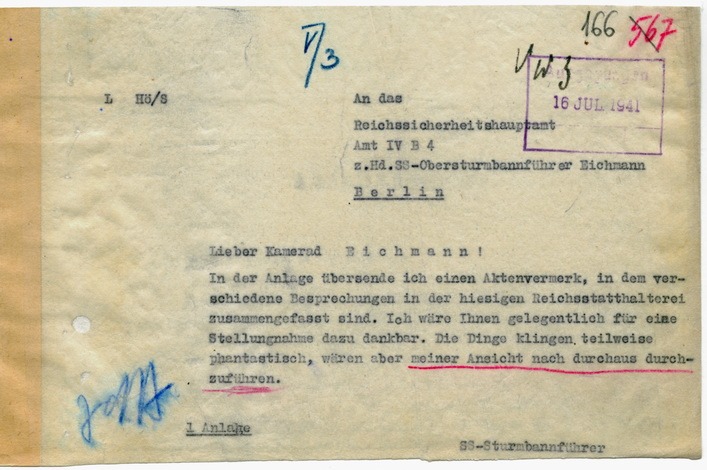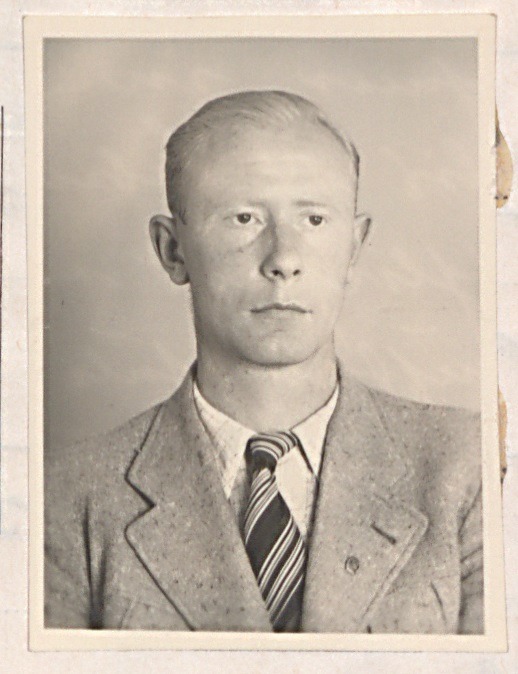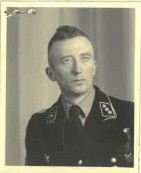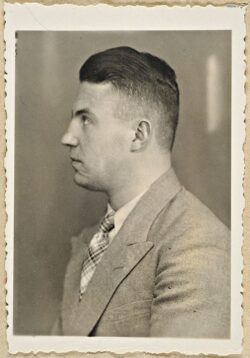The SS-Sonderkommando Kulmhof operated the Nazi extermination camp in the village of Kulmhof (today’s Chełmno) to annihilate Jews in the Warthegau region.
Latest Posts
On 8 July 1942, Albert Plate from the Sonderkommando Kulmhof discussed with the Ghetto Lodz Administration regarding the supply of cement, iron girders, and railroad tracks necessary for constructing open-air cremation furnaces in the forest camp of the extermination site. The Sonderkommando required a total of 30 tons of iron. In turn, Plate committed provision of 2,000 kg of diesel fuel to the Ghetto Lodz Administration to fuel the trucks used for transporting the belongings of murdered Jews to the sorting camp in Pabianice. Later, Ghetto Administration head Hans Biebow confirmed with Sonderkommando leader Hans Bothmann that they would receive 5,000 liters each of gasoline and diesel fuel.
Memo by SS-Sturmbannführer Herbert Strickner, head of RSHA Department III (Volkstum, or Ethnicity), analyzing occupation policy from 1939 to 1944 and outlining considerations for reorganizing Polish policy. The document, dated October 18, 1944, explores various approaches to manage the Polish population, with a particular focus on the Generalgouvernement. Strickner notes that “a final and official decision on the ultimate fate of the Polish people was not reached” and the Polish people “fear that they, similar to the Jewish people, are to be annihilated in their ethnic substance.”
On April 16, 1943, Hans Biebow, head of the Nazi’s Łódź (Litzmannstadt) Ghetto Administration, penned a letter to Friedrich Ribbe regarding the retrieval of a “transmission belt” promised by Sonderkommando Kulmhof. His letter contained a revealing remark that inadvertently exposed the Ghetto Administration’s complicity in the Chełmno extermination process: “The Gestapo has us to thank that the operation out there in K[ulmhof] ran smoothly.” Biebow urged Ribbe to discuss the issue with Alfons Rosse, the deputy head of the Gestapo in Litzmannstadt. Ribbe’s inquiry revealed that the transmission belt is no longer available, as it has been taken by SS-Standartenführer Paul Blobel, the commander of Aktion 1005.
On 15 July 1942, SS-Obersturmbannführer Ernst Fick, commander of the Sennheim training camp, requested a portable flamethrower unit from the SS Cavalry Brigade at the Waffen-SS training camp in Dębica to be provided to SS-Standartenführer Paul Blobel’s Sonderkommando 1005. Blobel subsequently tested the effectiveness of the flamethrower for corpse disposal at the Chełmno/Kulmhof extermination camp.
According to a radio message from September 15, 1942 and a trip report dated September 17, 1942, on 16 September 1942, a delegation from Auschwitz — consisting of Commandant SS-Obersturmbannführer Rudolf Höß, SS-Untersturmführer Franz Hößler, who was responsible for clearing mass graves, and SS-Untersturmführer Walther Dejaco from the Central Construction Office — visited Litzmannstadt to inspect “the test station for field ovens as part of Aktion Reinhard”, i.e. the open air cremation furnaces at the Kulmhof / Chełmno extermination camp The group examined the “special facility” and discussed its implementation at Auschwitz with SS-Standartenführer Paul Blobel. Blobel also ordered the delivery of “construction materials” and reserved a “ball mill for substances for Auschwitz concentration camp.”
Between 1940 and 1942, Franz Heinrich Bock served as Mayor and Official Commissioner of the Polish village of Poddębice. During this period, he kept a detailed diary documenting his experiences in Nazi occupied Poland, which was later published in 1961 under the pseudonym Alexander Hohenstein, with names of people and places changed (Poddębice became “Poniatowec”). On May 12, 1942, Bock described the visit of an SS officer to Poddębice, who came to oversee the collection of belongings left behind by the deported Jews. During their conversation, the SS officer disclosed that the Jews were killed in “specially constructed trucks” that “quickly and painlessly” kill those inside. The following day, Bock traveled to the Łódź Ghetto Administration to negotiate financial compensation for the deportation.
Wilm Hosenfeld, a German officer stationed in Warsaw during World War II, recounts in a diary entry of 23 July 1942 the actions of the German occupation, particularly the extermination of Jewish communities in occupied and annexed Polish territories. Hosenfeld learned specifically that “From Litzmannstadt and Kutno, it is said that Jews – men, women, and children – are poisoned in mobile gas vans, their clothes stripped from their corpses, and their bodies thrown into mass graves, with the clothing being sent to textile factories for reuse”.
In June and July 1942, the Ghetto Łódź Administration delivered large quantities of chlorinated lime and cement to the Sonderkommando at Kulmhof, according to the invoices addressed to the Secret State Police S[Sonderkommando] and internal correspondence of the administration. The materials were picked up by truck at the loading point at Baluter Ring (Balucki Rynek). For instance , on 21 July 1942 Sonderkommando member Erich Kretschmar confirmed the “receipt of 100 sacks of cement (one hundred) from the warehouse of the Ghetto Administration at Baluterring for the SS special operation”. The chlorinated lime was used to disinfect the mass burial sites, the cement was required for constructing the furnaces used for body disposal.
In March 1942, the Inspector of the Health Service under the Reich Commissary for the Consolidation of German Folk ordered 1,641 kg of chlorinated lime, which was commonly used as a disinfectant. The delivery was processed by Kopernikus Pharmacy in Posen and billed on 31 March 1942. The payment for the shipment, which was unloaded at Warthbrücken, the nearest train station to the Kulmhof extermination camp (Chełmno), was made through the special account of the Ghetto Administration in Litzmannstadt (Łódź Ghetto) through which the extermination camp was funded.
The letter dated 28 August 1942 discusses the transfer of furs confiscated from those murdered in Kulmhof (Chelmno) to the Waffen-SS, a branch of the Nazi military forces. According to the Higher SS and Police Leader in Posen, Wilhelm Koppe, a wagonload of “high-quality furs” had been delivered to Berlin for the benefit of the SS, with expectations of more to follow.
Deposition in Yiddish in February 1942 in the Warszaw Ghetto by Szlama Winer aka Jakub Grojnowski. In his account titled “Gvies-eydes funem tsvang-kabren . . .” (Testimony of a forced gravedigger), Winer reports his experiences in the Jewish working detail at the Chełmno (Kulmhof) extermination camp . Winer was deported from Izbica Kujawska to Chełmno on January 5, 1942 but managed to escape the camp on January 19, 1942.
On April 16, 1962, Adele Freigang, former resident of the village Chełmno nad Nerem (Kulmhof), provided a detailed testimony to West-German investigators . In autumn 1941, Freigang heard rumors of a Gestapo commando in Kulmhof, which later seized several key buildings. Reports surfaced about transports of Jewish people, initially believed to be going through a transit camp but later revealed to be destined for extermination. The victims were killed in gas vans, and their bodies disposed of in the nearby forest.
Interrogation protocol of Josef Peham, dated December 12, 1962, on his experiences in Kulmhof (Chelmno) extermination camp.
In a report titled “The Incidents in Kulmhof,” Hersz Wasser, the secretary of the Warsaw Ghetto underground organisation Oneg Shabbbat, describes the atrocities at the Chelmno Extermination Camp, also known as Kulmhof, during December 1941 and January 1942. The document was addressed to the Polish Home Army in April 1942.
On 8 March 1942, the F. Reichelt Aktiengesellschaft Litzmannstadt, a Pharmaceutical Company, issued an invoice to the Ghetto Administration in Lodz for “8 barrels of 100 kg chlorinated lime”. The bill was paid on May 7, 1942 from the special account 12300, suggesting that the materials were supplied to Chelmno extermination camp for desinfecting the mass grave in the forest camp.
Albert Plate, deputy commander of Kulmhof extermination camp, confirmed the correctness of the claim by Walter Becht, Disctrict Administrator of Warthbrücken (Koło) for reimbursement of lease loss for the district gardening ground next to the Kulmhof castle. The letter was sent on August 13, 1943, with the field post number of the Feldgendarmerie-Trupp 7 of SS-Freiwilligen-Gebirgs-Division Prinz Eugen.
On October 4, 1941, the Government President of Litzmannstadt, Friedrich Uebelhoer, wrote to Reichsführer-SS Heinrich Himmler, addressing the planned transfer of “at least 20,000 Jews and 5,000 Gypsies” to the Litzmannstadt Ghetto. The letter explained the ghetto’s current capacity issues (“if the Litzmannstadt Ghetto were a pure extermination ghetto, then one could consider even greater crowding of the Jews”) and the potential risks to the surrounding German population. In the end, he declared that he “must decline responsibility for the consequences in full” if the deportations of additional Jews and the Sinti and Roma will be carried out.
The letter dated June 24, 1943 was sent from Walter Becht, Disctrict Administrator of Warthbrücken (Kolo) to the State Police Office in Litzmannstadt. Becht reveals in this document that the SS-Sonderkommando Kulmhof took over the gardening area next to the estate with the “castle” (mansion) as early as October 1941. After the dissolution of the commando, the original tenant resumed full lease payments from April 1, 1943. The document requests reimbursement for the remaining lease loss of 50 RM for the period from October 1, 1942, to the end of March 1943.
Interrogation protocol of Wilhelm Görlich, former member of the SS-Sonderkommando Kulmhof, dated 21 December 1960, recorded in Bonn on his participation and experiences in the extermination camp Kulmhof (Chełmno).
On 16 August, 1941, the British intelligence intercepted a radio message from the Higher SS and Police Leader Center, Erich von dem Bach-Zelewski, to the Higher SS and Police Leader Posen, Wilhelm Koppe. In this communication, von dem Bach-Zelewski requested Koppe to “order the immediate deployment of Hauptsturmführer Lange, etc., to Baranowicze. On August 15, 1941, the day before, Himmler attended a demonstration shooting in Minsk and visited the Novinki asylum near Minsk. According to von dem Bach-Zelewski, Himmler ordered the facility to be cleared using a more humane method than shooting.
Interrogation protocol of Walter Burmeister, former member of the SS-Sonderkommando Kulmhof, dated 24 January 1961, recorded in Flensburg on his participation and experiences in the extermination camp Kulmhof (Chełmno). According to this, in late 1941, Burmeister was assigned to drive Hauptsturmführer Herbert Lange to Kulmhof (Chełmno), where a special unit was being formed for the extermination of Jews and others. He described his duties, which included managing the kitchen, driving duties, and distributing special rations. He also detailed the killing operations at Kulmhof, including the use of gas vans to murder victims. Burmeister admitted to giving deceptive speeches to victims about to be killed and driving gas vans. He claimed he could not recall his thoughts or motivations at the time, nor could he explain why he did not resist the orders.
Two days after Bach-Zelewski requested Sonderkommando Lange to come to Baranowicze, on August 18, 1941, the British intelligence intercepted another radio message from the Higher SS and Police Leader Center, Erich von dem Bach-Zelewski, to the Higher SS and Police Leader Posen, Wilhelm Koppe. Von dem Bach-Zelewksi acknowledged that Sonderkommando is not available at the moment, but stressed again “that Lange be made temporarily available to me upon becoming available” as he would like “to have the procedure demonstrated to me personally” by him.
Interrogation protocol of Fritz Ismer, former member of the SS-Sonderkommando Kulmhof, dated 9 November 1960, recorded in West-Berlin. Ismer mentions his transfer to Kulmhof (Chełmno) under SS-Hauptsturmführer Lange and describes the mass murder using gas vans and burial in mass graves. He admits that he handled the valuables taken from victims but denied participation in violence. In spring 1942, cremation ovens were built for burning of the bodies in the mass graves. Ismer also mentions SS-Standartenführer Blobel, who directed the open air cremations.
Certified copy of interrogation protocol of former forester Hans Staegemeir, dated 30 August 1961, recorded in Paderborn (West-Germany) on his experiences and observations on the extermination of Jews near Kulmhof (Chełmno). Staegemeir was appointed as a district forester to Wartheland and witnessed unusual and secretive operations involving the transportation of Jewish people and the ominous presence of gas vans. The area was heavily policed and eventually fenced off and raised suspicions among local forestry officials. Staegemeir described the regular shuttle movement of sealed, gray vehicles that resembled small furniture vans, intensifying in frequency, sometimes every 10 minutes. His observations are also recalled in Heinrich May’s manuscript on Kulmhof from early 1945.
Certified copy of interrogation protocol of forestry official Heinrich May dated 13 December 1960, recorded in Bonn (West-Germany) on his experiences and observations linked to the Holocaust operations near Kulmhof (Chelmno). May was a longstanding member of the NSDAP and SS, career took a dark turn during WWII when he found himself managing a forestry office near Kulmhof extermination camp. May witnessed suspicious activities, including the movement of “gas vans” used for exterminating Jewish individuals. Despite not seeing the killings firsthand, the evidence was overwhelming, with frequent sightings of smoke rising from the forest. Bothmann, the commander of the Sonderkommando operating the site, later revealed to May the presence of mass graves and confirmed the scale of the atrocities. At the end of the war, May penned a manuscript, “The Great Lie,” which recounted these grim details but was never published. In the post-war interrogation, May corroborated the details presented in his manuscript.
The document details a list of transports carrying 16,748 Jews from Radegast Station in the Łódź Ghetto to Przybyłów near Kulmhof, conducted between March 16 and April 2, 1942.
At the end of 1941, the SS-Sonderkommando leader Herbert Lange recruited Plate to the extermination camp Kulmhof. After the departure of SS-Obersturmführer Herbert Otto in early 1942, Plate assumed the position of acting camp commander until the camp’s dissolution. In this role, Plate was a key figure in the extermination of Jews at Kulmhof. He personally shot members of the Jewish work commando selected for execution.
The document provides a list of transports with 10,348 Jews deported between March 1 and 15, 1942 from Radegast Station in the Litzmannstadt (Łódź) Ghetto to Warthbrücken. It was used to establish the transportation costs, which were reviewd by SS-Hauptscharführer Alfred Stromberg from the Stapo Litzmannstadt on March 27, 1942.
The document is dated April 22, 1942 and was written by Forschungsstelle A Litzmannstadt (Łódź), a local branch of Hermann Göring’s Secret Service Forschungsamt of the Reich Ministry of Aviation. The message recalls a statement by Robert Schefe of the Litzmannstadt Stapo office that “All Jews in the Warthegau capable of working would be resettled into the Litzmannstadt Ghetto after the removal of those unfit for work”. Furthermore, he noted that “those Jews not capable of working would be placed in so-called care camps” – an euphemistic term for Kulmhof extermination camp.
The document, dated January 16, 1941, was addressed from Forschungsstelle A in Litzmannstadt to Forschungsamt 5 A 3. Both offices were part of Hermann Göring’s Secret Service, the Forschungsamt of the Reich Ministry of Aviation. The telex communicates details from Herbert Weygandt of the Stapo office in Litzmannstadt about forthcoming actions in the ghetto. He mentioned the planned “resettlement beginning on January 16 of 10,000 non-working Jews – involving whole families” and following this “a complex currently housing approximately 8,000 Jews will be removed from the ghetto”.
The telex, dated December 9, 1941, was sent from Forschungsstelle A Litzmannstadt to Forschungsamt 5 A 3, both of which were components of Hermann Göring’s Secret Service Forschungsamt of the Reich Ministry of Aviation. The message from the Litzmannstadt branch mentions a conversation involving Robert Schefe, the head of the local Stapo office that “by order of the Gauleiter, the sick from the ghetto should be ‘removed’.” Furthermore, when questions were raised about whether central authorities in Berlin had been informed of this decision, the response of the Stapo “was evasive”. The term “removed” implies the extermination of the sick in Kulmhof extermination camp, where the operation was ramped-up at the time. The evasive answer about informing Berlin suggest a possible attempt to manage such operations discretely or independently at the local level, indicating the decentralized nature of some Nazi policies.
The letter, dated December 3, 1942, from Himmler to SS-Obergruppenführer Greiser, acknowledges Dr. Blome’s concerns regarding the proposed plan to address incurable tuberculosis patients. Himmler “carefully reconsidered whether the original idea should be implemented in some form” but concludes that “Proceeding against the sick in the intended manner, in my opinion, is not feasible”. Instead, he suggests now an alternative approach, advocating for the relocation of these patients to a designated area. Additionally, he emphasizes the importance of properly leveraging propaganda to support this action.
The letter, dated November 21, 1942, from the Reich Governor of the Reichsgau Wartheland Posen to Reichsführer-SS Heinrich Himmler, discusses the authorization granted “to subject those members of the Polish community who are proven to be afflicted with open and thus incurable pulmonary tuberculosis to special treatment”, which effectively meant execution. Despite thorough evaluation and planning, concerns regarding implementation were raised by Professor Dr. Blome, Deputy Head of the Main Office for Public Health of the NSDAP, in a letter dated November 18, 1942. Greiser seeks Himmler’s opinion on whether to inform the Führer about this stage of the process. However, he personally believes such consultation of Hitler may not be necessary, citing that previousy “regarding the Jews, he told me to proceed at my own discretion”.
While the Nazi authorities in the Warthegau were already planning the killing of Polish individuals incurably afflicted with tuberculosis, concerns were raised by the Main Office for Public Health of the NSDAP. In a letter dated 18 November 1942 to Arthur Greiser, the Reich Governor of the Wartheland, Kurt Blume detailed the plan of the Warthegau authorities where “approximately 35,000 incurable and contagious Poles would be given special treatment.” He also noted that Greiser “obtained approval for the special treatment from the appropriate authorities,” (e.g. the Security Police and Reichsführer SS) but stressed the need to ensure “explicitly that the Führer truly agrees with such a solution.” Blume pointed out that Hitler “already halted the action in the asylums some time ago, and currently does not consider ‘special treatment’ of the hopeless patients politically expedient or acceptable.” Overall, Blume expressed that “secrecy is simply impossible… one day even the relatives of the patients will notice that ‘something is not right here,’ even with the best efforts at secrecy.”
After receiving the request from the government of the Warthegau to kill Polish nationals suffering from incurable tuberculosis through the use of the Sonderkommando Lange, Rudolf Brandt from the Personal Staff of the Reichsführer-SS sought a statement from the Chief of the Security Police, Reinhard Heydrich, on this matter. On June 9, 1942 ( after Heydrich’s death), Gestapo Chief Heinrich Müller reported that there were “no objections to Polish nationals of the Wartheland region, who are afflicted with open tuberculosis and stateless individuals of Polish ethnicity, being subjected to special treatment as proposed by Gauleiter Greiser”, however, “the implementation must be as inconspicuous as possible”.
On May 3, 1942, in a coordinated action with the Reich Governor Arthur Greiser of the Reichsgau Wartheland, Wilhelm Koppe, the Higher SS and Police Leader in the same region, reached out to Rudolf Brandt, Personal Staff of the Reichsführer-SS. Their aim was to secure Himmler’s approval “for the transfer of those Poles who are demonstrably suffering from open tuberculosis to Kommando Lange for special treatment”, effectively meaning their execution by the Sonderkommando Lange, then operating the Kulmhof extermination camp.
On May 1, 1942, Arthur Greiser, the Reich Governor in the Reichsgau Wartheland, relayed to Reichsführer-SS Heinrich Himmler that “The action of special treatment of around 100,000 Jews in my district, which you approved in agreement with the Chief of the Reich Security Main Office, SS-Obergruppenführer Heydrich, will be completed in the next 2-3 months”, pertaining to the death toll of Kulmhof extermination camp. Additionally, Greiser proposed “to eradicate cases of open TB within the Polish ethnic group here in Warthegau” by “using the existing and incorporated Sonderkommando after the Jewish action”, suggesting the involvement of Sonderkommando Lange (then under the leadership of Hans Bothmann) in the extermination of Poles with open tuberculosis.
On February 6, 1942, Martin Luther of the German Foreign Office forwarded an anonymous letter to Gestapo chief Heinrich Müller. The letter concernced “alleged incidents in the course of the solution of the Jewish question in the Warthegau”. In his response to Luther two weeks later, classified under the reference number “Geheime Reichssache (1005)”, Müller acknowledged misconduct against Jews in the Warthegau, noting that “where the axe falls, chips will fly”. However, he pointed out that these “measures” were often exaggerated to elicit sympathy and foster hope for an end to them. Müller emphasized that “the Jew tries to escape his well-deserved fate.” The letter is considered as a starting point for the later operation known by the codename “Aktion 1005.”
The document describes the fate of 127 individuals identified as “Jews with children under 14 years,” deported from Kalisch by the Sonderkommando Lange on December 1, 1941. Notably, the memo recounts the escape of Mojsie Nejmanowicz, Sara Nejmanowicz, and Nechemja Nejmanowicz from the camp. Additionally, it mentions that the possessions of the deportees will be collected by the “Gestapo.” See also the report by the same author regarding a prior deportation supported by local police in Kalisch.
This document of November 22, 1941 was written by Hauptmann Speckmann from the regular police in Kalisch (Kalisz) and describes procedures for the deportation of Jews by Sonderkommando Lange. The killer commando is referred to as “official of the Special Representative of the Secret State Police.” The handwritten memo provides detailed instructions regarding guard duty. Furthermore, it discusses the consolidation of areas and the apprehension of escaped Jews. The document concludes with the temporary stop of the so-called “Jewish action” as ordered by Sonderkommando Lange, withdrawal of guard duty and the transfer of workshop keys to an official of the Economic Office. Thus, the document provides some valuable insights into the logistics of the deportation of the Jews during the phase when Sonderkommando Lange operated as a mobile killing unit.
In January 1942, authorities in the Warthegau region grappled with the spread of typhus originating from Sinti and Roma victims, who had been deported from the Litzmannstadt ghetto, to the extermination site of Sonderkommando Kulmhof. At least half of the Polish workers in the Sonderkommando were infected. The local health office detailed these typhus cases in Kulmhof in a letter to the president of the government of Hohensalza (Inowrocław) on January 24, 1942. The report referred to the camp staff as “members of the Sonderkommando” and the Polish laborers as the “Polish working detail,” each group housed separately. Additionally, it mentioned the “Jewish working detail,” who were accommodated in the palace of Kulmhof.
On September 2, 1941, Rolf-Heinz Höppner, head of the Central Migration Office in Posen, outlined plans for reorganizing the office to address the impending task of “resettling millions of people”. Höppner stressed that it is “essential…to have complete clarity from the outset about the ultimate fate of these displaced ethnic groups unwanted in the Greater German Settlement Areas—whether the goal is to secure a certain life for them permanently or to eradicate them entirely.”
On January 6, 1942, Herman Krumey, the head of the Migration Central Office in Litzmannstadt, recorded the names of three SS men provided by the Migration Central Office to Sonderkommando Lange: SS-Obersturmführer Herbert Otto, SS-Hauptscharführer Fritz Ismer, and SS-Scharführer Karl Goede. The group was accompanied by the driver Grebe, whose first name remains unknown.
On December 18, 1941, Ernst Damzog, the Inspector of the Security Police and SD in Posen, wrote to Hermann Krumey, the head of the Migration Central Office Litzmannstadt, that he has “informed SS-Hauptsturmführer Krim.-Kommissar Lange about the delegation of the 3 SS leaders or sub-leaders to his commando”. The notorious obligation declaration, binding all members of the Sonderkommando to strict secrecy, was scheduled to be administered personally by Lange.
Hans Staegemeir was forester of the area at Kulmhof extermination camp. He observed the activities of theSonderkommando and shared his experiences with his superior, Forester Heinrich May. Members of the Sonderkommando visited his forestry office to make telephone calls. Staegemeir also had the opportunity to visit the extermination site in the forest camp.
On July 16, 1941, authorities in the Reichsgau Wartheland convened to deliberate on what was euphemistically termed the “solution of the Jewish question.” Rolf-Heinz Höppner, head of the SD and Umwandererzentralstelle (Migration Center Office) in Posen, forwarded the discussed proposals to Adolf Eichmann, seeking his feedback. Höppner himself regarded the suggestions as “fantastic,” yet entirely viable.
The following report, dated February 1945, was authored by Heinrich May, detailing his experience and knowledge of the Kulmhof (Chelmno) extermination camp in the Warthegau. The document integrates May’s firsthand observations on-site, explanations provided by members of Sonderkommando Kulmhof, and descriptions relayed by other visitors of Sonderkommando Kulmhof.
In March 1942, Bothmann assumed the role of commander at the Kulmhof extermination camp, succeeding Herbert Lange in this position.
Heinrich May served as the head of the forestry office in Warthbrücken (now Koło) within the Warthegau region, which included overseeing operations at the Kulmhof Forestry. Between 1941 and 1944, May bore witness to the atrocities committed at the Kulmhof extermination camp.
Lange oversaw the infamous Sonderkommando Lange and subsequently assumed command at the Kulmhof extermination camp. In this capacity, he bore the responsibility for orchestrating the systematic slaughter of both inmates of asylums and Jews within the Warthegau region.







